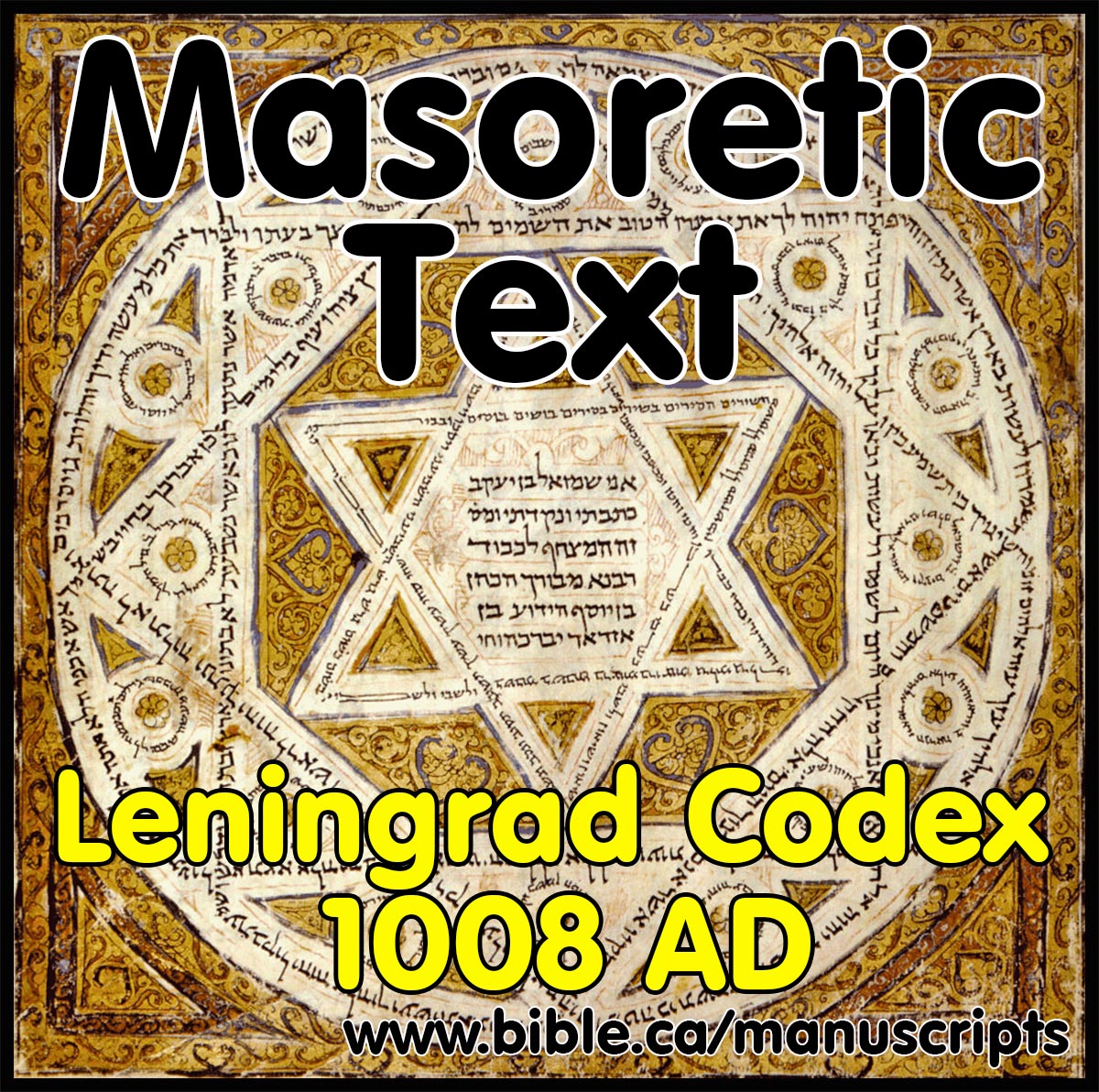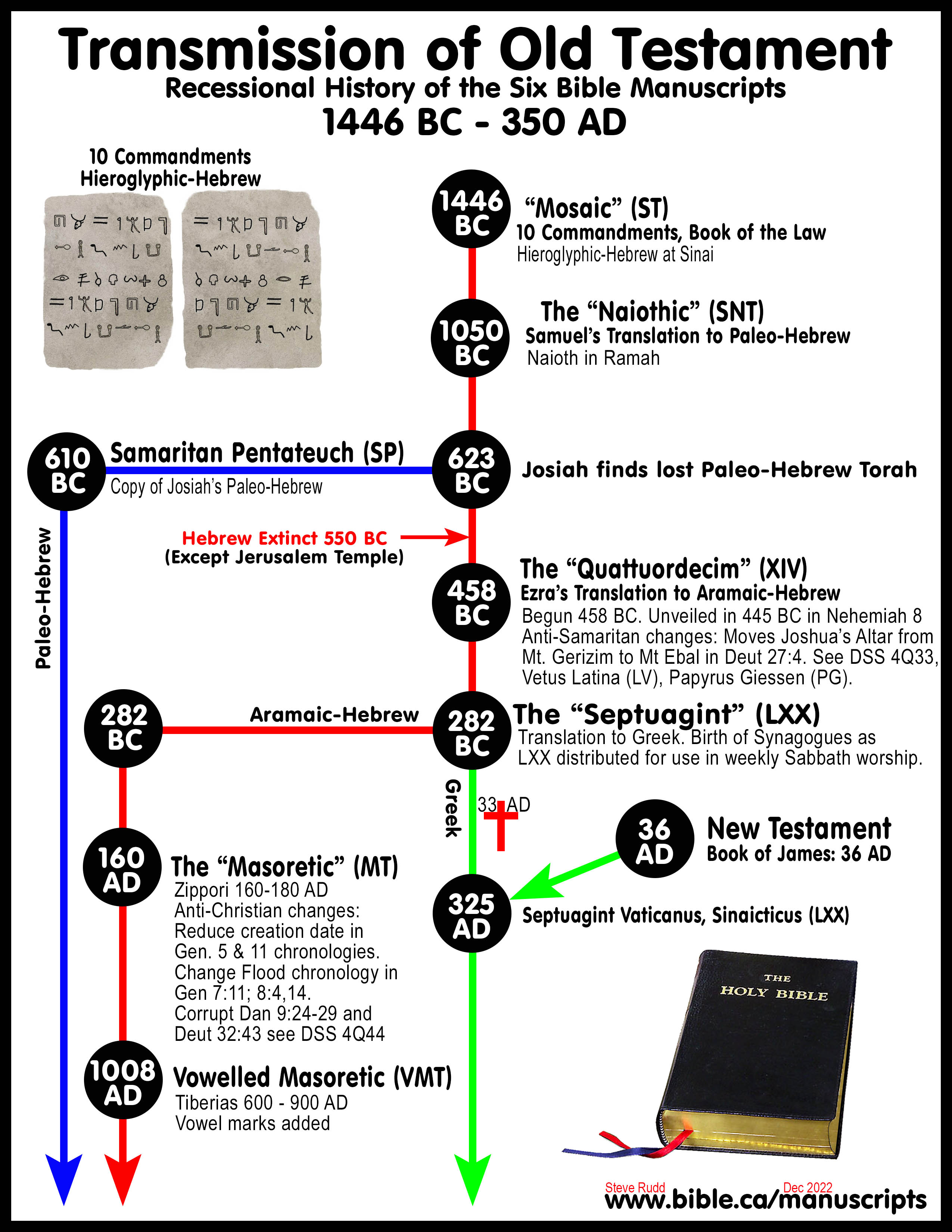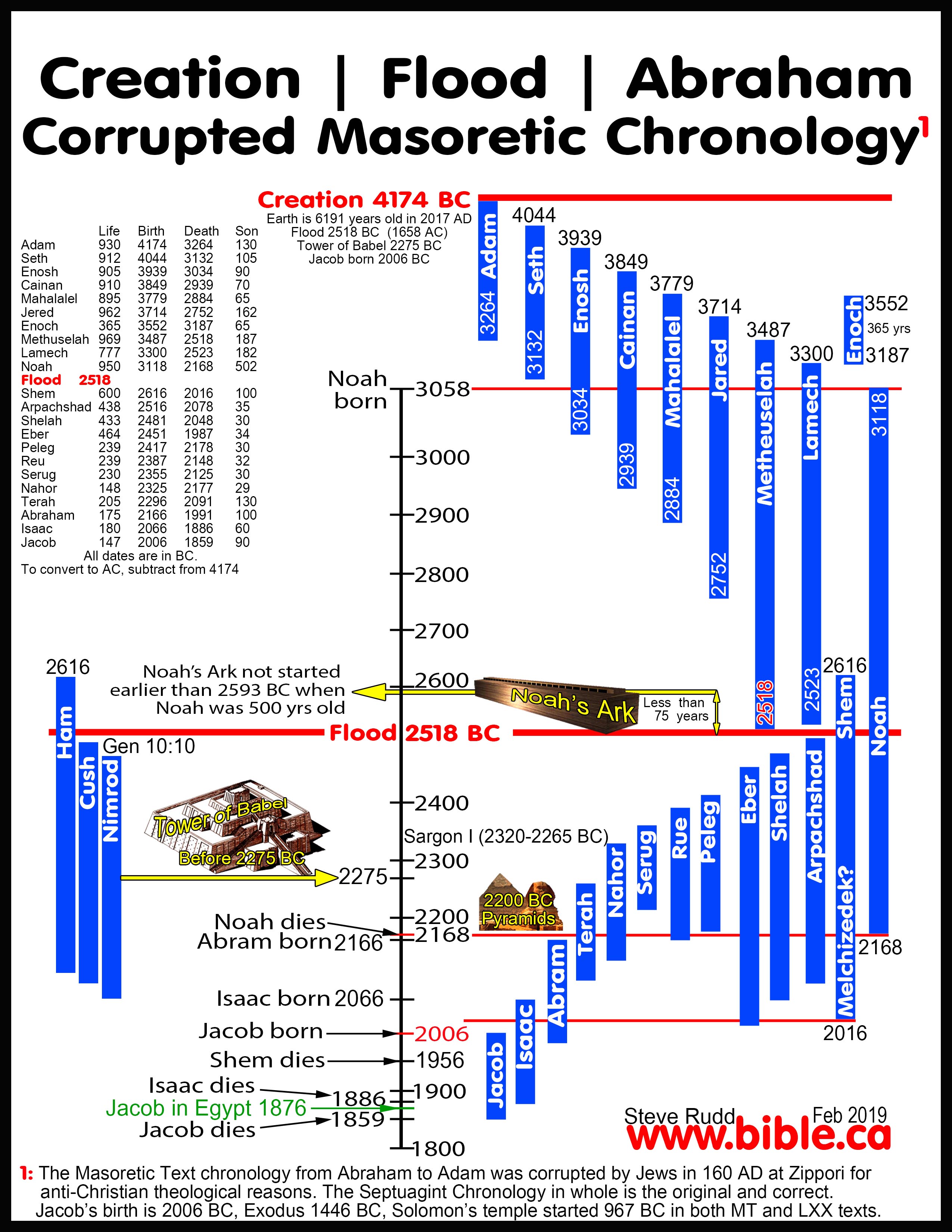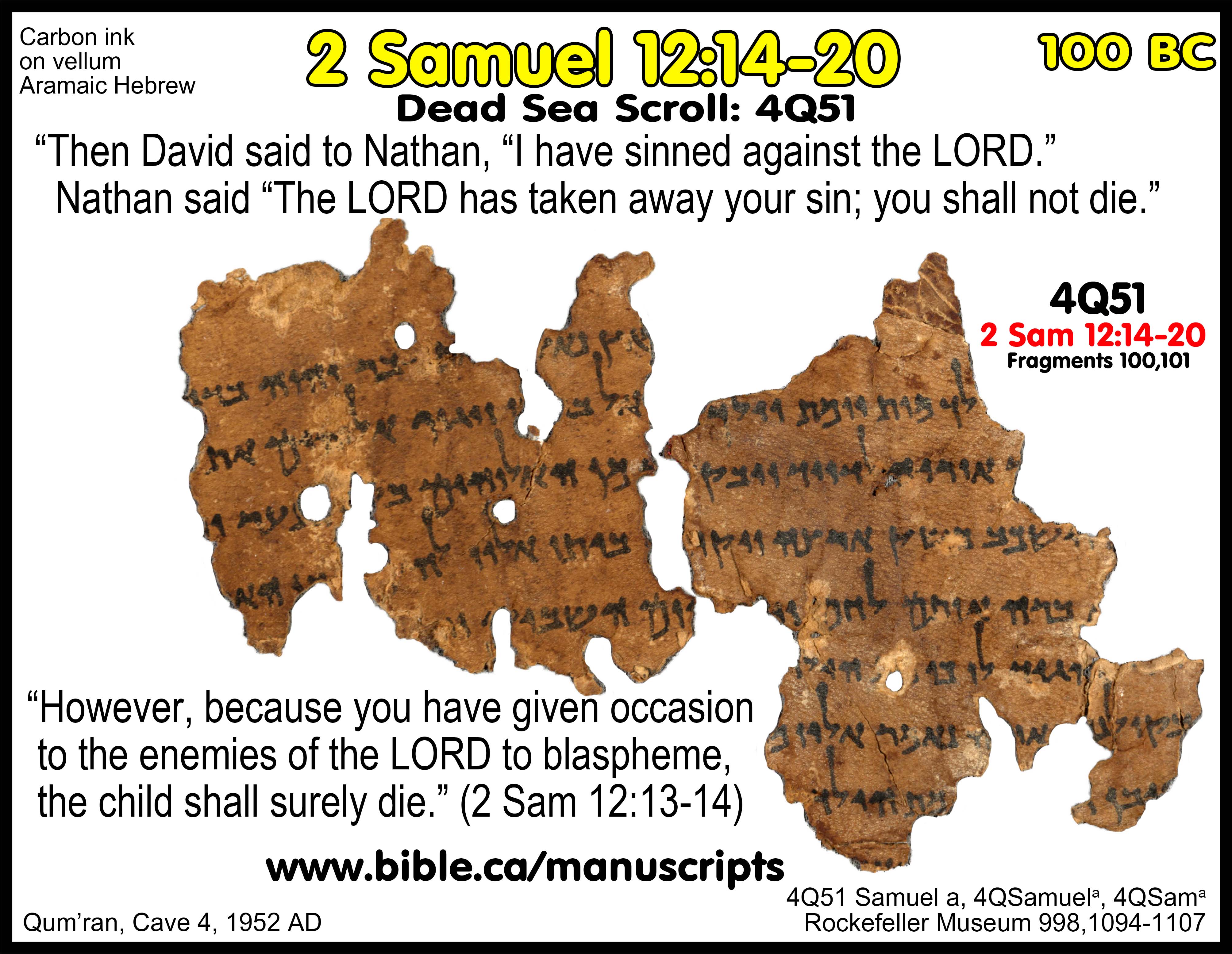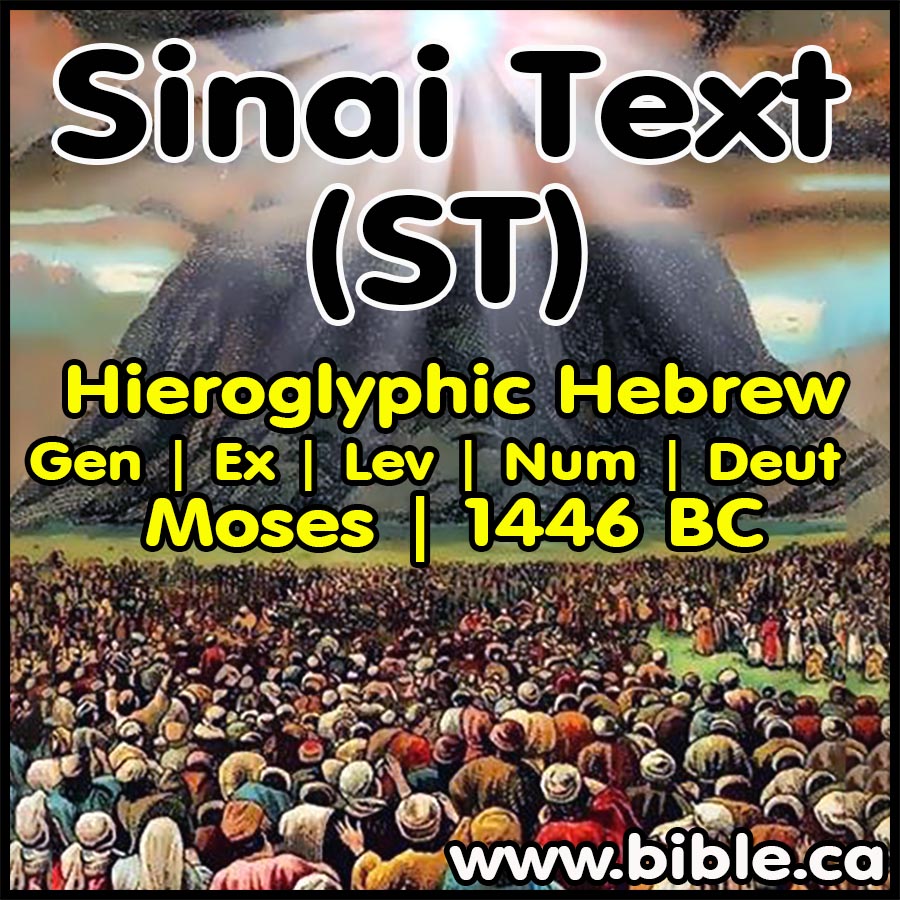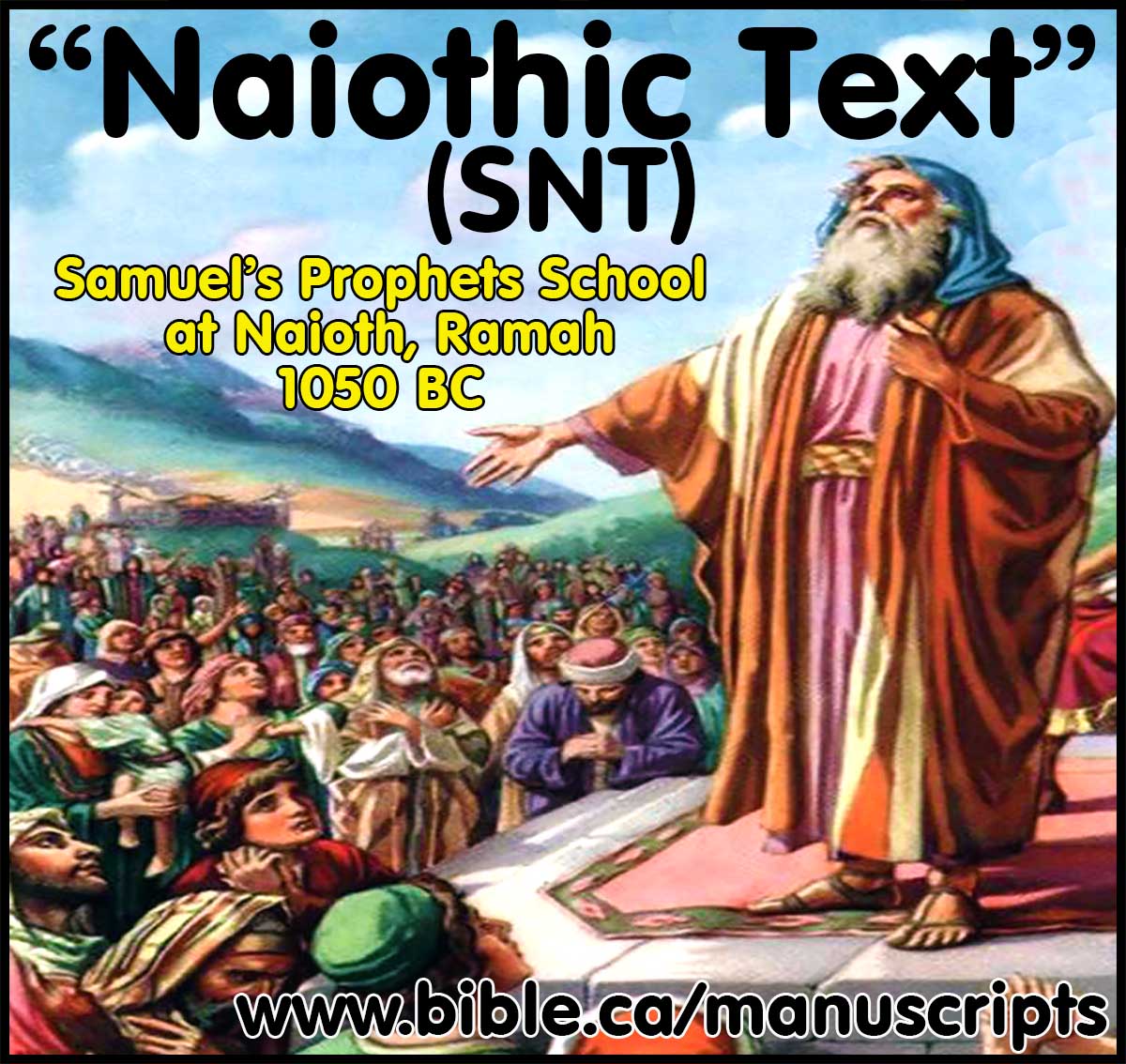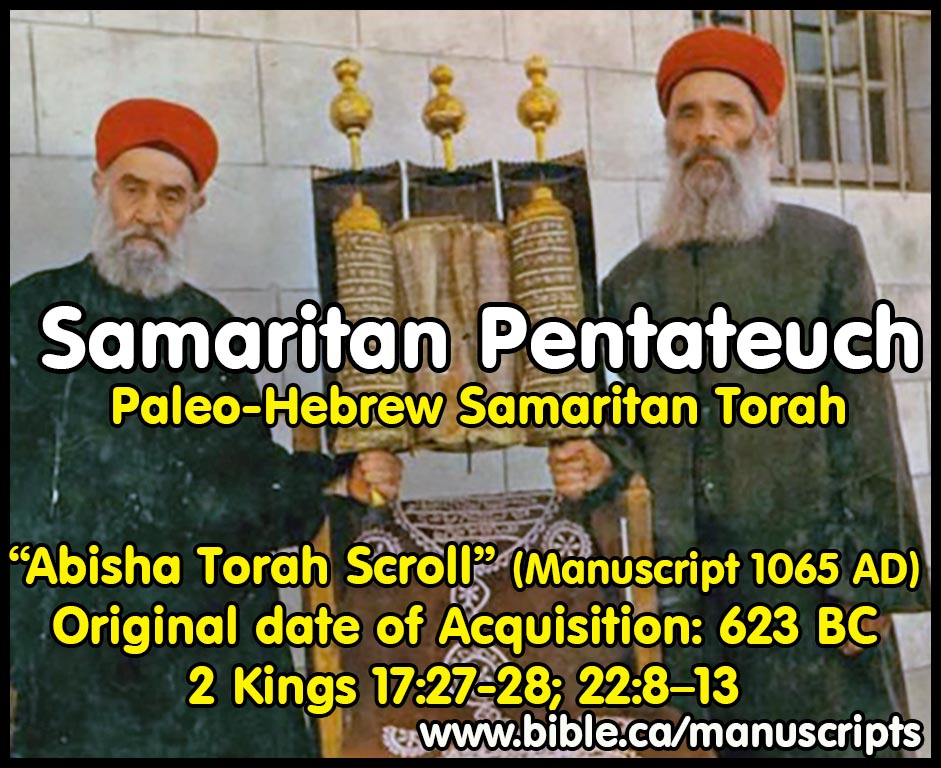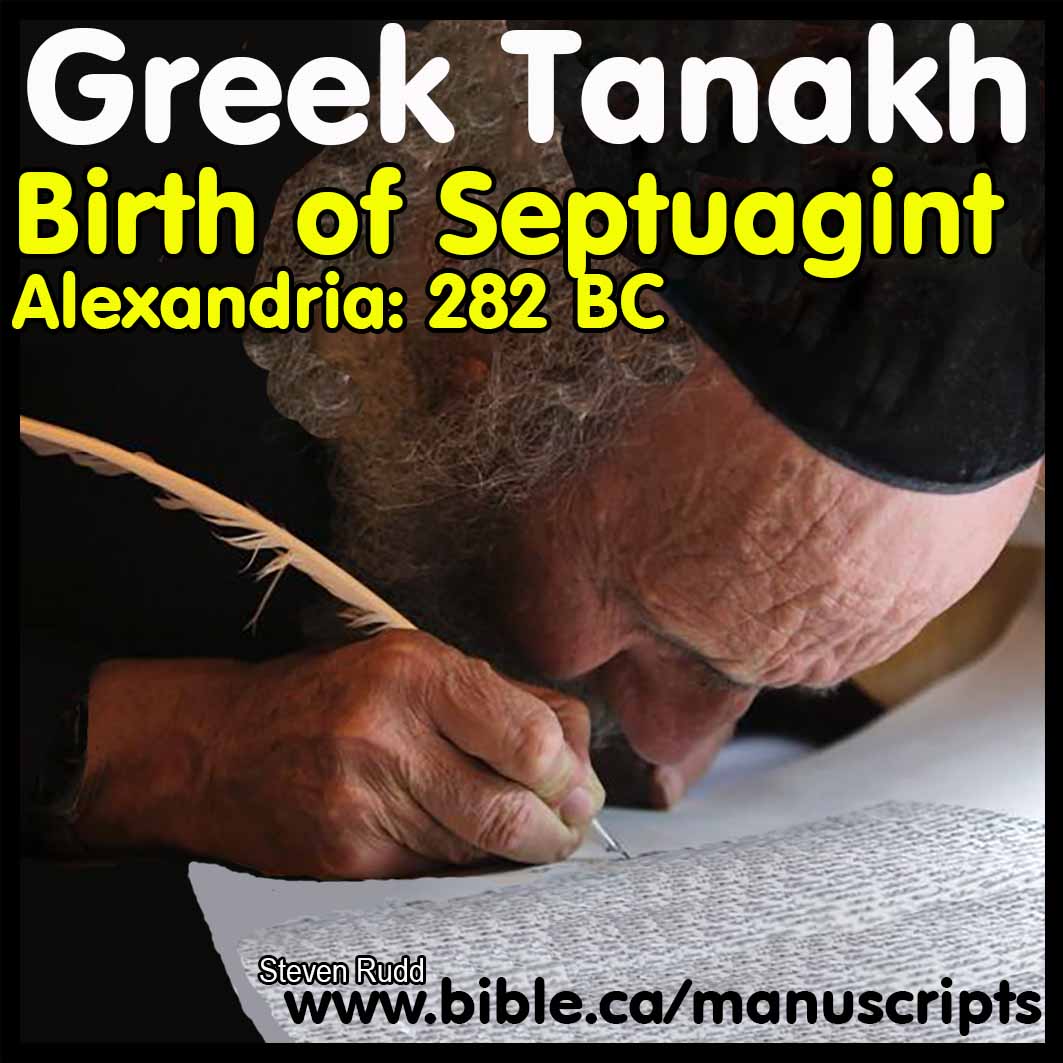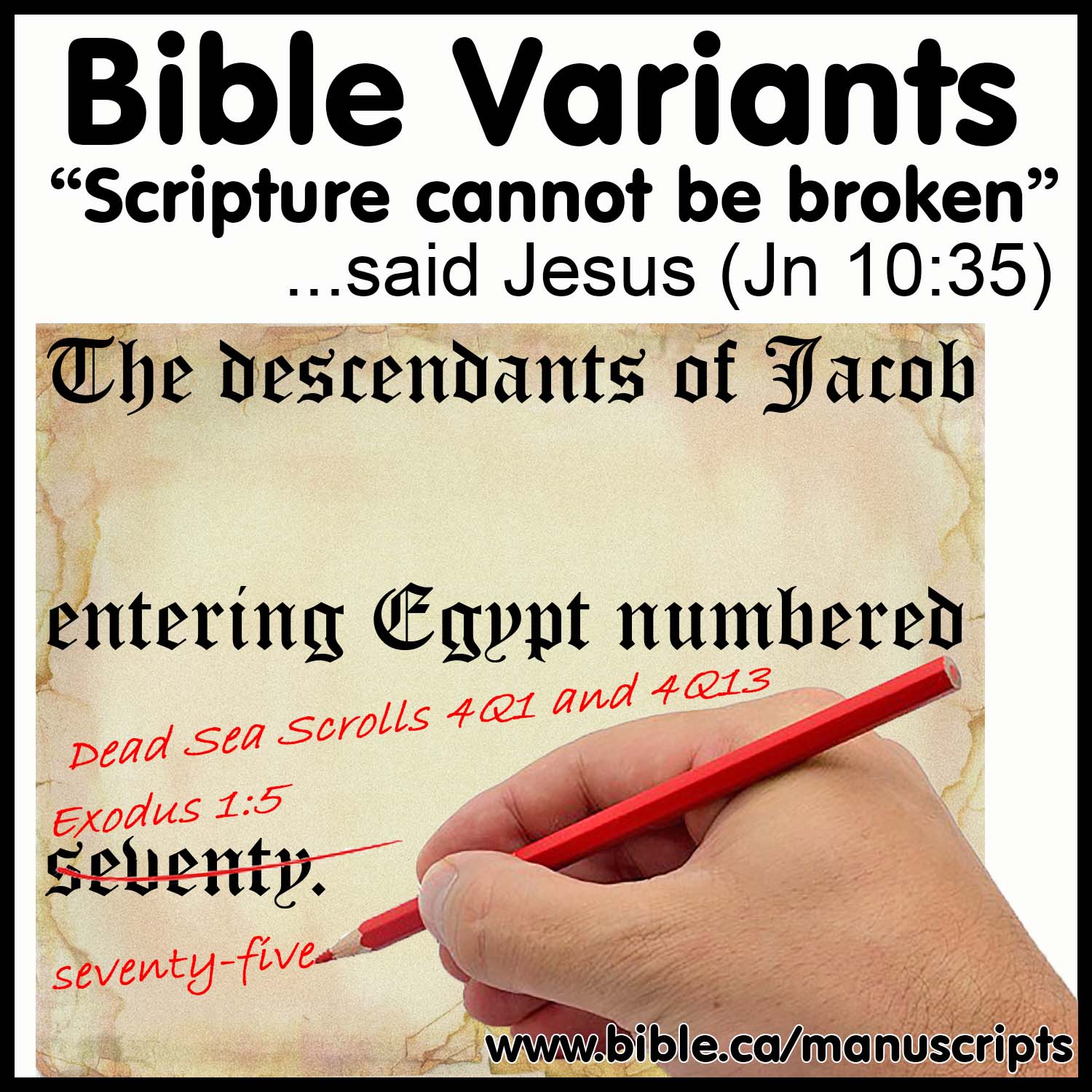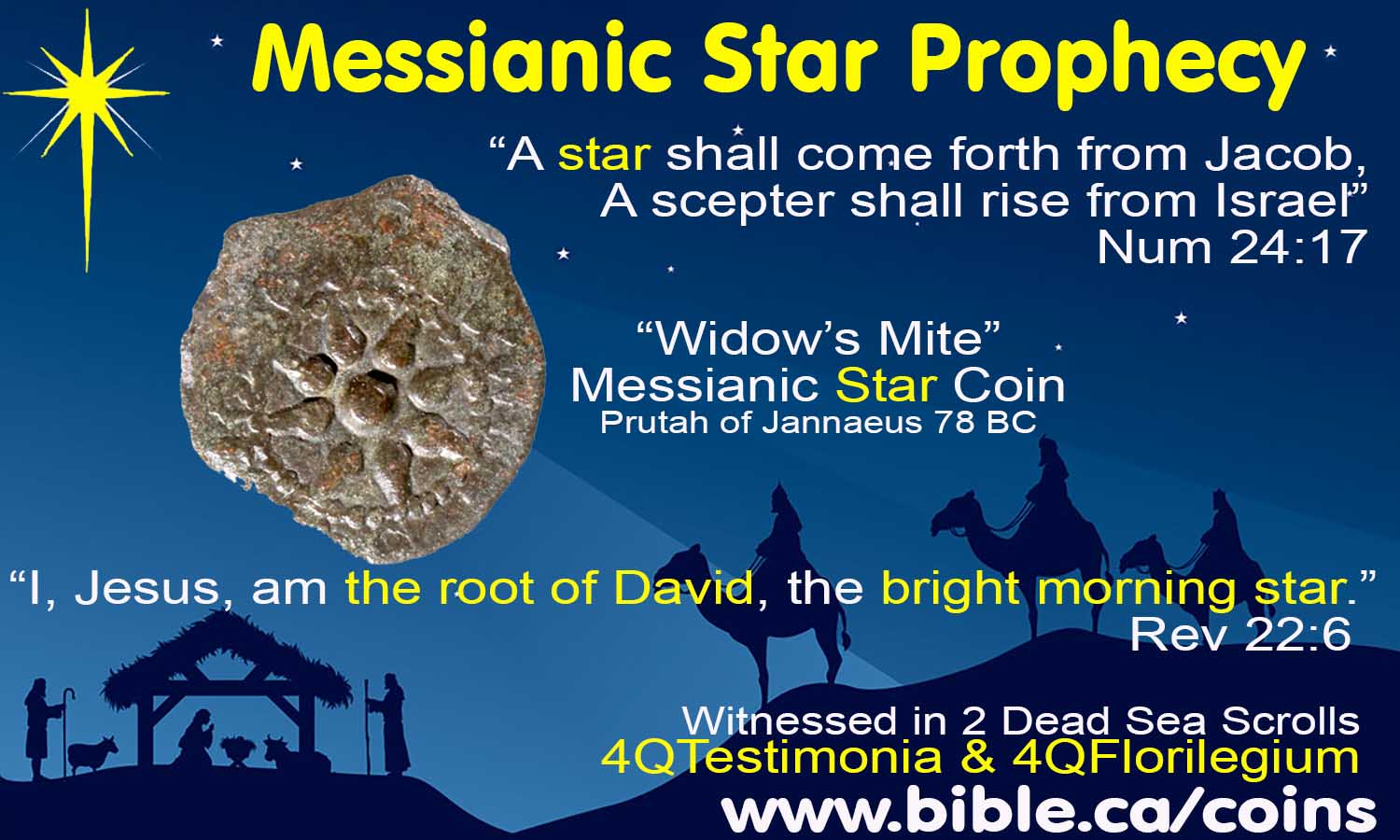|
|
|
|
Birth of the Masoretic Text (MT) By Rabbi Yose ben Halafta in 160 AD at Zippori Jews deliberately corrupted their Hebrew Tanakh to counter Christian theology and the Masoretic Text was born "My word will accomplish what I desire and succeed "Scripture cannot be broken" (Jesus, John 10:35) Steve Rudd 1017 |
|
|
|
|
|
|
|
Masoretic Text (MT) born in 160 AD at Zippori
|
Six Manuscripts of the Old Testament |
|||||
|
Name |
Date |
Authors |
Place |
Content |
Language |
|
Mosaic (ST) |
1446 BC |
Moses |
Sinai |
Book of the Law, Torah |
Hieroglyphic Hebrew |
|
Naiothic (SNT) |
1050 BC |
Samuel |
Naioth, Ramah |
Torah, Joshua |
Paleo-Hebrew |
|
Samaritan Pentateuch (SP) |
623/610 BC |
Samuel |
Naioth, Ramah |
Torah (copy from Josiah) |
Paleo-Hebrew |
|
Quattuordecim (XIV) |
458-445 BC |
Ezra “the 14” |
Jerusalem |
Tanakh, (Except Neh., Mal.) |
Aramaic-Hebrew |
|
Septuagint (LXX) |
282 BC |
“the 70” |
Alexandria |
Tanakh |
Greek |
|
Masoretic (MT) |
160 AD |
Rabbi Yose ben Halafta |
Zippori |
Tanakh |
Aramaic-Hebrew |
Introduction:
1. The Masoretic Text we have today: Codex Leningrad and the Mikraot Gedolot
a. The oldest Hebrew manuscript in the world is the Codex Leningrad manuscript that dates to 1008 AD.
b. “In 1542 the Jewish Masoretic Text was approved in its final form, the Ben-Hayyim edition, superseding all previous editions and preserving them only for critical research.” (The Israelite Samaritan version of the Torah: p xxviii, 2013 AD)
c. The Mikraot Gedolot, known as the second Rabbinical Bible, was finalized by Ben-Hayyim (Jacob ben Haim or Yaakov ben Hayyim ibn Adonijah). The Mikraot Gedolot was printed in Venice by Daniel Bomberg (1524 AD). The Mikraot Gedolot of ben Hayyim was used by the 1611 AD King James Version translators for the Old Testament.
d. “BIBLES, RABBINIC, called also Great Bibles (Miḳraʾot* Gedolot): Hebrew Bibles containing, besides the original text, the commentaries of sundry Jewish rabbis. The first of these Bibles was published by Daniel Bomberg, edited by Felix Pratensis (4 parts, Venice, 1517–18); it contains, besides the Hebrew, the Aramaic paraphrases and commentaries of eight different writers on certain books, Masoretic notes, and other matter. As the editor (Felix Pratensis) was a (Jewish) convert to Christianity, his work did not prove acceptable to the Jews. Its faults induced Bomberg to undertake another edition, for which he employed as editor the celebrated Masoretic scholar Jacob ben Hayyim, who in after-life also embraced Christianity.” (The new Schaff-Herzog encyclopedia of religious knowledge, Volume 2, Page 168)
e. “Most printed editions reproduce essentially the same text of TgPss as that found in the first Rabbinic Bible, edited by Felix Pratensis and printed by Daniel Bomberg in Venice in 1517. The second Rabbinic Bible, edited by Jacob ben Hayyim, and printed by Daniel Bomberg also in Venice in 1524–25, was the first printed Hebrew Bible to have a Masora in the margin, and the text it reproduced became the standard Masoretic Text for over 400 years. This edition also set the norm for the layout used in subsequent Rabbinic Bibles.” (The Aramaic Bible, Psalms, Vol 16, p22)
f. “The work of the Venetian printer Daniel Bomberg, a wealthy Christian merchant from Antwerp, was destined to have the greatest influence on the subsequent history of the printed Hebrew Bible. At the encouragement of a Jewish convert to Christianity, Felix Pratensis of the Order of Augustinian Hermits, Bomberg sponsored the editing and printing in 1515–1517 of what has come to be known as the First Rabbinic Bible, a four-volume work fully pointed and accented, with Targums and rabbinic commentaries in the margins. The edition is also noteworthy for having the Christian chapter divisions marked for the first time in a Hebrew Bible, for dividing the books of Samuel, Chronicles, and Ezra-Nehemiah into two books each, and for recording the consonants of the qere readings for the first time in the margins.” (ISBE, Text of the Old Testament, Vol 4, p 810)
g. It is ironic that the three key men who produced the Mikraot Gedolot Jewish Bible (Daniel Bomberg, Felix Pratensis and Ben-Hayyim) were all Jewish converts to Christianity. Editor Felix Pratensis converted before he worked on the Hebrew Text and editor Ben-Hayyim converted to Christianity after intense work with the Old Testament!
2. Two periods of corruptions in the Tanakh: 458 BC and 160 AD
a. On two different historic occasions, the Jews corrupted their own Bible to counter theological adversaries. The Jews in 160-200 AD corrupted the Genesis chronology for anti-Christian purposes unknowingly following in the footsteps of Ezra in 458 BC who, for anti-Samaritan purposes, changed the location of Joshua’s alter from Mt. Gerizim to Mt Ebal as he converted the Paleo-Hebrew Tanakh into Aramaic Hebrew to create the Quattuordecim (XIV). Noah got drunk, David committed adultery. Perhaps this one textual corruption was Ezra’s great sin. Notice that in both cases, the entire collection of Hebrew manuscripts were entrusted into the hands of a small number of Jews who created a single manuscript that would come to dominate the world, all within a population who were Hebrew illiterate and would be unable to detect the changes.
b. Despite two waves of deliberate Jewish corruptions of their own Hebrew Bible, the Hebrew Masoretic text of the Old Testament retains all the historical and theological information God intended his creatures to know in order to become Christians. In other words, the variants make zero difference to anything important.
c. The Masoretic Hebrew Text of the Old Testament was first standardized at Zippori by Rabbi Yose ben Halafta in 160 AD
d. This Zippori text was inherited by the Masoretes at Tiberias in 600 AD and they added vowel accenting marks to create the Codex Leningrad manuscript that dates to 1008 AD.
3. The Masoretic text as we have it today was standardized by anti-Christian Jews in Zippori in 160 AD
a. After suffering major losses in 70 and 135 AD, the manuscripts of the bible lay in the hands of a tiny group of Jews at Zippori.
b. They engaged in making some significant anti-Christian corruptions to the Hebrew Bible which explains some of the key variants between the MT and the Septuagint (LXX)
4. The
Hebrew Bible was written in four different scripts:
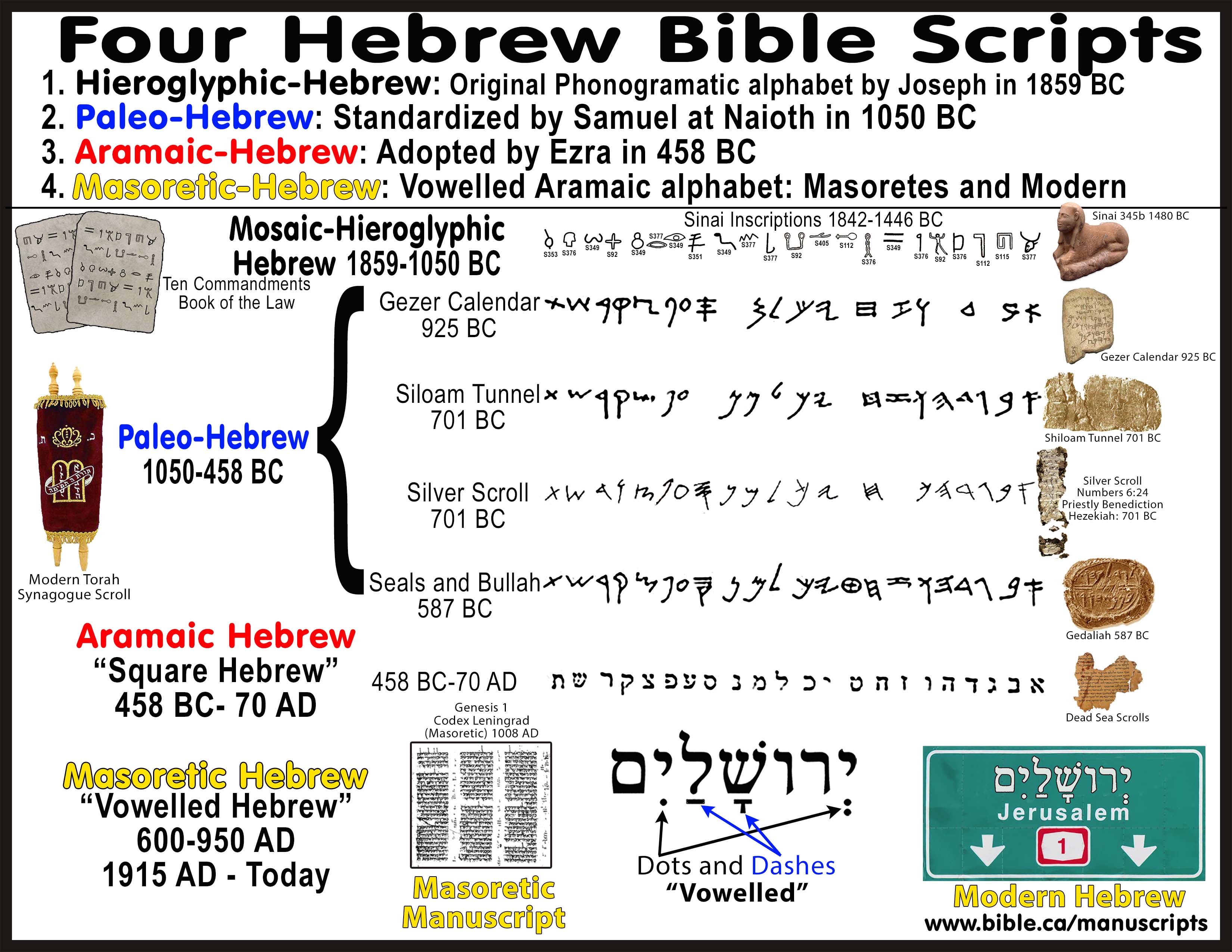
4. The Hebrew Bible has existed in 6 different “autograph” forms:
|
See also: 1. Author’s Preface and Master Introduction 2. 6 Old Testament Manuscripts 3. Origin of the 4 Hebrew scripts used by Jews 4. Book of Law in Hieroglyphic Hebrew alphabet script
|
I. Single textual variants in the Old Testament: LXX vs. MT
1. Methuselah was 187 years old when Lamech was born not 167: Gen 5:25
2. Jacob enters Egypt with 70 or 75 persons: Gen 46:27; Ex 1:5; Deut 10:22; Acts 7:14
3. Genesis Flood Chronology: Three calculated, deliberate variants in Gen 7:11; 8:4, 14.
4. 471 LXX Verses Identical with SP and Different from MT
II. Dead Sea scrolls that validate the Septuagint against the Masoretic text:
1. Hebrew DSS that agree with the LXX against the MT
2. Hebrew DSS that disagree with both the LXX and MT
3. Hebrew DSS that validate the Samaritan Pentateuch and LXX
4. 154 Dead Sea Scroll variants identical to SP & LXX against the MT
III. The deliberate Jewish corruptions of the Hebrew Text:
1. 458 BC: Ezra’s theologically driven, anti-Samaritan variants: Birth of Ezra’s “Quattuordecim”:
a. Ezra’s Variant: Deut 27:4: Joshua’s Altar on Mt. Gerizim
b. Ezra’s Variant: Change of tense from past “has chosen” to future “will chose”
c. Ezra’s Variant: Lev 26:31 change of singular “sanctuary” to plural “sanctuaries”
d. Ezra’s Variant: Deut 11:30 Deleted words “opposite Shechem”
e. The “smoking gun” that Ezra changed the Hebrew text and not the Samaritans
2. 160 AD: Anti-Christian, theologically driven variants by Rabbi Yose ben Halafta at Zippori
a. Shem was NOT Melchizedek. Shem died before Abraham was born.
b. Shem was second-born and NOT Melchizedek. Japheth “the Great” was firstborn in the LXX.
c. Angels are commanded to worship Jesus Christ in Deut 32:43 in the LXX (Heb 1:6)
d. The 70 weeks of Daniel 9 end in 33 AD with the resurrection of Christ in the LXX.
e. Jews corrupt the Synagogue Septuagint Tanakh: Jews alter the LXX, then abandoned it forever.
f. Reduction in the age of the earth in the Hebrew Torah Chronology (see below)
IV. Reduction in age of earth: Anti-Christian, theologically driven variants in 160 AD at Zippori
1. The corrupt Masoretic chronology is found in all Christian Bible’s including the KJV, NASB, NIV etc.
a. The chronology is so obviously corrupt, it is shocking that more Christians have not recognized this before.
b. The Masoretic Chronology used Seder Olam Rabbah as its blueprint for compressing earth history for anti-Christian theological reasons.
c. Masoretic Chronology like Seder Olam, is an extreme compression of real Jewish history so that every descendant of Noah down to Abraham (except Peleg), was alive when Abraham was born. This means that Noah, Shem, Pachshad, Shelah, Eber, Rau, Serug and Nahor may have attended Abraham’s first birthday party and might have helped Abraham blow out his one birthday candle.
d. Every descendant of Noah after the flood not only lives to see Abraham, but in some cases outlives Abraham!
e. Remember, the Jews wrongly have Abraham born when Terah was 70 rather than 130 which from a Jewish point of view, shifts Abraham 60 years earlier which means even Peleg lives past the birth of Abraham. Christians corrected this error 60 year error.
f. Another huge problem is the population dynamics. From the flood to the Tower of Babel to Abraham is only 358 years. In those 358 years you must start with 8 persons, fill the earth to the tower of Babel, then disperse the population again sufficiently to build the great pyramids in the 100 years after babel.
g. This creates another huge problem from an archeological point of view, not only is there insufficient manpower to build the pyramids, they date to about 2500 BC, which from the Septuagint chronology, is a full 800 years after the flood.
2. Using Seder Olam Rabbah, there are actually two ways that Jews compressed history in order to theologically exclude Jesus Christ as the Messiah:
|
|
|
|
Seder Olam Rabbah is the smoking gun that the Jews changed their scripture |
|
|
|
|
a. First, using Seder Olam Rabbah, the Jews in 160 AD reduced the age of the earth from 5554 BC to 4174 BC in order to push Jesus outside their 1708 year window of expectation between 4292 – 6000 years after creation. (See below)
b. Second, using Seder Olam Rabbah the Jews in 160 AD used this compressed history to redefine the Messianic 490 years of the 70 weeks of Daniel 9:24-29 so that it extends between the destruction of the first temple (587 BC) to the Roman destruction in 70 AD. Taken at face value it was almost universally believed in the first century that the 70 weeks began in 458 BC and ended exactly 490 years to the solar day on 5 April 33 AD, the day Jesus the Messiah rose from the Dead. Additionally, they corrupted the text of Dan 9 in the Hebrew Bible but the autograph text can be seen in the Septuagint Codex Vaticanus. See: The 70 weeks of Daniel 9 end in 33 AD with the resurrection of Christ
c. See also: Jewish
Messianic expectation and theology
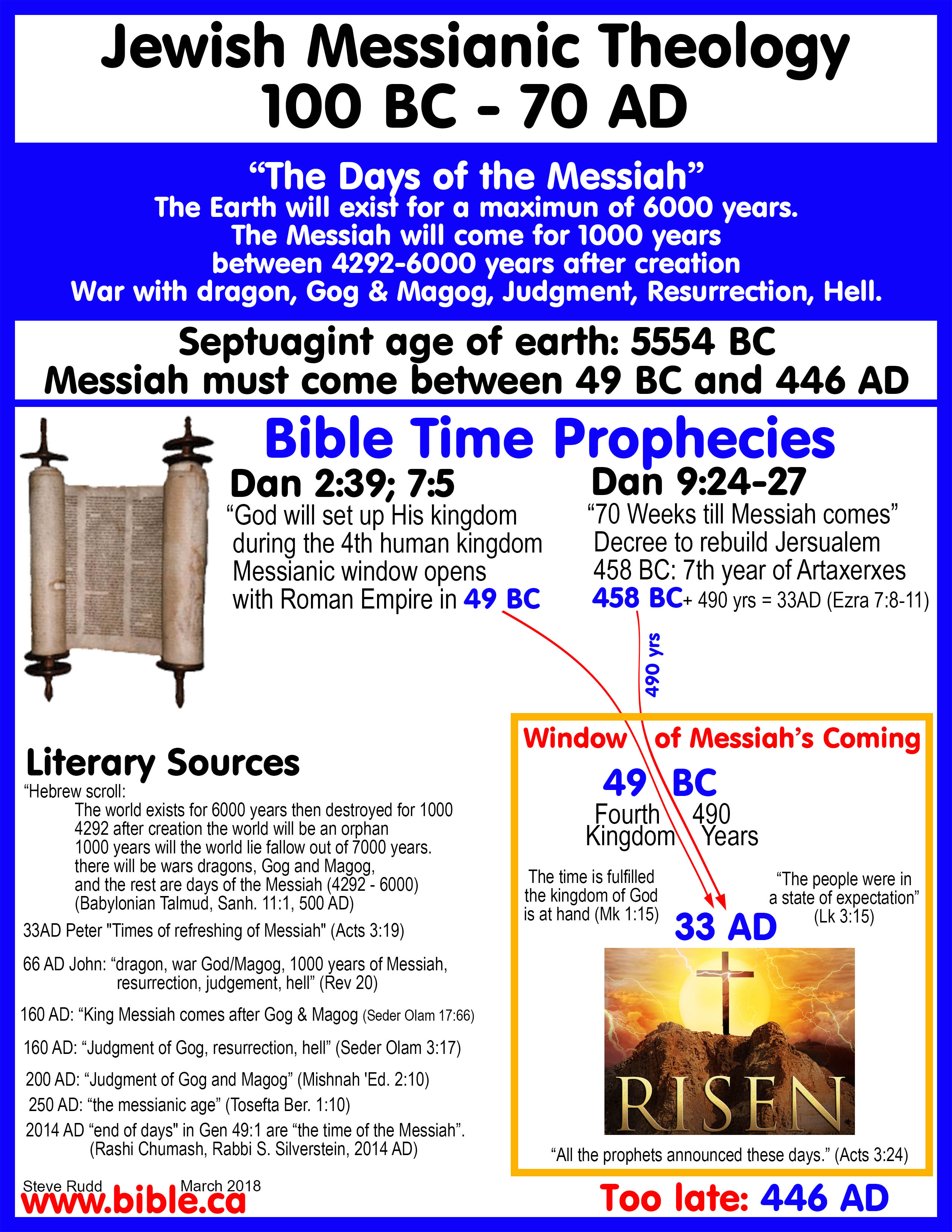
3. The Jews in 160 AD, reduced the age of the earth from 5554 BC to 4174 BC in order to push Jesus outside their 1708 year window of expectation between 4292 – 6000 years after creation.
a. This man-made, non-Biblical Jewish eschatological idea is witnessed in the Babylonian Talmud, b. Sanh. 11:1, I.88.A–91.F and is believed by Jews down to the present time. Pushing Jesus Christ outside this window was done by the Jews in 160 AD by corrupting the chronological numbers in Gen 5,11. The autograph originals are preserved in the Septuagint.
b. The original age of the earth was a perfect fit for Jesus as the expected messiah who started his ministry (30 AD) in year 5474 After creation (AC). The new corrupted numbers as reflected in the Masoretic text that underlies most Bibles today, have Jesus coming in year 4207 which is 88 years to early. However, since the Jews in 160 AD down to the present wrongly believe Terah was 70 instead of 130 when Abraham was born, creation to them was 60 years shorter at 4114 BC.
c. In the Jewish mind in 160 AD, therefore, their new fudged numbers had Jesus come ([4114 + 30] - 4292 = 148) 148 years too early. In their mind, the beginning of the 1708 year window for the coming of the Messiah started in 178 AD. This worked fine for the Jews in 150 AD because it ruled out Simon Bar Kokhba who was universally believed to be the Messiah until Hadrian killed him in 135 AD AND it meant that the very Jews who corrupted the numbers were themselves on the brink of the windows for the coming messiah which would lasts 1708 years.
d. Little did the Jews know in 160 AD that the Jewish messiah has STILL NOT COME TODAY almost 2000 years later. According to the Masoretic Text the close of the messianic window is year 6000 after creation or 1886 AD. This is why Jews today have actually abandoned the chronology of their own Tanakh (Masoretic Text) and use the even more corrupted chronology of the Seder Olam Rabbah, which sets year 6000 at 2239 AD.
e. If you find this hard to believe just type into Google “Jewish date 2017” (where 2017 is the current calendar year) and you will see the result is 5778 years after creation. So Jews today expect the messiah to come before year 6000 AC (2017 AD + [6000 - 5778] = 2239 AD) which is 2039 AD. This dating system was invented in 150 AD by the Jews in their Seder Olam.
4. Seder Olam is the smoking gun as the first time in history that the chronological numbers in today’s Masoretic text are recorded exactly.
a. This proves a cause and effect that the Seder Olam came first and the corruption in the Hebrew Bible merely copied the numbers from Seder Olam into Genesis 5 and 11.
b. The Seder Olam is a corrupt chronology universally rejected as historic because, for example, it gives the Persian empire only 52 years when in fact it existed 205 years.
5. The Hebrew Text matched the Septuagint in 100 AD: The evidence is almost irrefutable to prove this.
a. In 100 AD, the primeval chronologies in Genesis from Adam to Abraham were identical. The numbers in the Hebrew manuscripts matched the Greek Septuagint. In the first section, we documented the messianic fever and symbolism that existed for two hundred years (100 BC – 100 AD). In the second section, we documented that there was almost universal agreement in both the extant Hebrew (MT) and Greek (LXX) chronological numbers down to 100 AD. In other words, the chronological numbers of Genesis 5&11 that calculate the older age of the earth as seen in today’s Septuagint, were identical to the Hebrew Masoretic text at the time of Christ and the first century church. Then in the second century AD, the Jews began deliberately corrupting key messianic passages and the chronology of Genesis in order to disqualify Jesus as the messiah of prophecy.
b. The blindness that led the Jews to reject the miracles of Christ morphed into jealously that led the Jews to crucify Jesus, which morphed into deceit which led them to lie about the disciples stealing the body of Jesus, which morphed into a hatred of Jesus Christ so intense they chose to corrupt the text of their Sacred writings. This 100 year old pattern of blindness, jealousy, deceit and hatred for Christ exceeded their love of their scriptures which Christians used against them to clearly proved Jesus of Nazareth was their messiah. Rather than convert to Christ they chose to corrupt their Tanakh. Corrupt or convert. They did the unthinkable and chose to corrupt their scriptures. Their rejection of Christ led directly to the millions of Jews killed in the first Jewish war of 66-70 AD at Jerusalem, two mass suicides at Gamla and Masada and Hadrian’s holocaust in the second Jewish war of 132-135 AD. All this unnecessary death when Jesus the Nazarene (branch of David) offer them eternal life.
c. Jewish rabbis today knowingly follow this corrupt dating system from the Seder Olam, where the year 2017 AD is equal to the Jewish calendar year 5777 AC (after creation). This Seder Olam directly contradicts the original uncorrupted Genesis chronologies as witnessed in the Septuagint by a whopping 1799 years and the corrupted Genesis chronologies as witnessed in the modern Masoretic text used by Jews in Synagogues with a difference by 413 years. In other words, the Chronological numbers in the Hebrew Tanakh read by Rabbis in every Synagogue today are ignored in favor of the man-made Seder Olam chronology. If Jews were honest they would discard the Seder Olam chronology and at least use the corrupted Masoretic Chronology in the book of Genesis. If they did, the year 2017 would be 6191 AC. Of course, the true age of the earth, as recorded in the Greek Septuagint in the year 2017 would be 7577 AC.
6. Creation dates of all reliable ancient literary sources validate the longer Septuagint Chronology:
225 BC: Demetrius the chronographer: 5500 BC
170 BC: Book of Jubilees: 3906 BC (estimate) This is a fictitious chronology.
158 BC: Eupolemus: 5307 BC
10 AD: Testament of Moses: 4221 BC Follows Book of Jubilees
30 AD: Philo of Alexandria: c. 5500 BC Uses Hebrew text not the Septuagint
60 AD: Pseudo-Philo 5886 BC
70 AD: Josephus 5467 BC Uses Hebrew text not the Septuagint
90 AD: 2 Esdras 14 5464 BC
100 BC: Testament of Levi and the Twelve Patriarchs
150 AD: Justin Martyr Jews corrupt their own Greek Synagogue Tanakh
160 AD: Seder Olam Rabbah: 3761 BC corrupt chronology identical to the Modern Masoretic Text
221 AD: Julius Africanus Sextus: 5500 BC Uses Hebrew text not the Septuagint
384 AD: Vulgate by Jerome: 4114 AD Latin translation of Hebrew
400 AD: Augustine: believed both 5554 BC and 4114 BC were inspired
7. Test case for accuracy of LXX vs. Masoretic: Shem as Melchizedek
|
Primeval Chronology of Genesis 5 |
|||||||||
|
|
Greek Septuagint (LXX) (Correct original) |
Hebrew Masoretic (MT) (Corrupted in 150 AD) |
Samaritan Pentateuch (SP) (corrupted) |
||||||
|
Man |
Age at Son's Birth |
Remaining Years |
Life |
Age at Son's Birth |
Remaining Years |
Life |
Age at Son's Birth |
Remaining Years |
Life |
|
Adam |
230 |
700 |
930 |
130 |
800 |
930 |
130 |
800 |
930 |
|
Seth |
205 |
707 |
912 |
105 |
807 |
912 |
105 |
807 |
912 |
|
Enosh |
190 |
715 |
905 |
90 |
815 |
905 |
90 |
815 |
905 |
|
Cainan |
170 |
740 |
910 |
70 |
840 |
910 |
70 |
840 |
910 |
|
Mahalalel |
165 |
730 |
895 |
65 |
830 |
895 |
65 |
830 |
895 |
|
Jared |
162 |
800 |
962 |
162 |
800 |
962 |
62 |
785 |
847 |
|
Enoch |
165 |
200 |
365 |
65 |
300 |
365 |
65 |
300 |
365 |
|
Methuselah |
187 |
782 |
969 |
187 |
782 |
969 |
67 |
653 |
720 |
|
Lamech |
1821 |
565 |
753 |
182 |
595 |
777 |
53 |
600 |
653 |
|
Noah |
5022 |
450 |
950 |
5022 |
4503 |
950 |
5022 |
450 |
950 |
|
Total years4 |
2158 years |
1558 years |
1209 years |
||||||
|
Flood5 |
3298 BC |
2518 BC6 |
3108 BC |
||||||
|
Steve Rudd 2017 AD |
|||||||||
1. Lamech’s begetting age for Noah in the LXX reads 188 but this is a scribal error and the correct age Lamech’s son Noah was born is in his 182th year in the MT which is the autograph reading.
2. Japheth was firstborn when Noah was 500, Shem second-born when Noah was 502 and Ham the youngest. We know for certain that Shem was not firstborn as per Gen 11:10 and that Ham was the youngest as per Gen 9:24 which obviously makes Japheth the oldest. In Gen 10:21 English translators are split on which of Shem and Japheth were the oldest. The Hebrew in the MT and SP could mean either that Japheth or Shem were the older brother. The Greek LXX calls Japheth “the great” which may mean he is older than Shem or that he was older and/or more famous than Shem.
3. Gen 9:28-29 says Noah lived 350 years after the flood but for a total life of 950 years. Genesis 7:6 says the flood occurred when Noah was 600 years old.
4. Creation to birth of Shem in Noah’s 502nd year as per Gen 11:10.
5. Flood occurred in the 600th year of Noah or 98 years after Shem was begotten when Noah was 502 years old.
6. Because Jews have wrongly believed from 300 BC to the present that Terah was 70 years old when Abraham was born instead of the correct begetting age of 130 you must add 60 years to the MT flood date of 2558 BC to arrive at the actual MT flood date of 2618 BC.
|
Primeval Chronology of Genesis 11 |
|||||||
|
|
Septuagint (LXX) (Correct original) |
Masoretic (MT) (Corrupted in 150 AD) |
Samaritan (SP) (Corrupted) |
||||
|
Man |
Year at Birth |
Rem./Life9 |
Year at Birth |
Rem./Life9 |
Year at Birth |
Rem. Years |
Life9 |
|
Shem1 |
100 |
500/600 |
100 |
500/600 |
100 |
500 |
600 |
|
Arphaxad |
135 |
430/565 |
35 |
403/438 |
135 |
303 |
438 |
|
Cainan |
130 |
330/460 |
Skipped |
- |
skipped |
- |
- |
|
Shelah |
130 |
330/460 |
30 |
403/433 |
130 |
303 |
433 |
|
Eber |
134 |
370/504 |
34 |
430/464 |
134 |
270 |
404 |
|
Peleg |
130 |
209/339 |
30 |
209/239 |
130 |
109 |
239 |
|
Reu |
132 |
207/339 |
32 |
207/239 |
132 |
107 |
239 |
|
Serug |
130 |
200/330 |
30 |
200/230 |
130 |
100 |
230 |
|
Nahor |
79 |
129/208 |
29 |
119/148 |
79 |
69 |
149 |
|
Terah2 |
130 |
75/205 |
130 |
75/205 |
708 (130) |
75 (158) |
145 |
|
Gen 11 Yrs3 |
1230 years |
450 years |
1100 years |
||||
|
Gen 5 Yrs |
2158 years |
1558 years |
1209 years |
||||
|
Abram born |
2166 BC |
2166 BC |
2166 BC |
||||
|
Creation4 |
5554 BC |
4174 BC5 |
4475 BC |
||||
|
Flood6 |
3298 BC |
2518 BC7 |
3168 BC |
||||
|
Steve Rudd 2017 AD |
|||||||
1. Shem begat Arphaxad at age 100 which was two years after the flood.
2. Christians know from Acts 7:4 that Abraham was born when Terah was 130 years old not 70. This is an interpretive variance, not a textual one in spite of the fact that Jews from 300 BC to the present wrongly maintain that Terah was 70 when Abraham was born.
3. Total years from birth of Arphaxad to birth of Abraham in 2166 BC.
4. Creation date is derived by adding the begetting columns in both charts to the date Abraham was born in 2166 BC.
5. The Jews from 300 BC down to the present day wrongly set the age of Terah at the birth of Abraham at 70 which calculates an age of the earth at 4114 BC. The truth is that Terah was 130 years old, which calculates age of the earth according to the MT at 4114 BC + 60 = 4174 BC.
6. Flood date is calculated by subtracting [total Gen 5 years] from [creation date] and adding [98 years] because Shem was born in Noah’s 502nd year and the flood occurred when Noah was 600 years old.
7. Because Jews have wrongly believed from 150 BC to the present that Terah was 70 years old when Abraham was born instead of the correct begetting age of 130 you must add 60 years to the MT flood date of 2458 BC to arrive at the actual MT flood date of 2518 BC.
8. While the numbers in the MT show that Terah was 130 when Abraham was born and that Abraham left Haran at age 75 after Terah died at age 205, the Jews incorrectly interpreted the birth of Abraham when Terah was 70. What this meant in their interpretation, was that Tarah continued to live in Haran for another 60 years after Abraham left for Canaan. This was always problematic until the Christian Bible explicitly stated that Abraham did not leave Haran until after the death of Terah at age 205 (see Acts 7:4). The Samaritans fudged the numbers for the life span of Terah from 205 down to 145 in order to have Terah die before Abraham left Haran. So in the Samaritan corrupted chronology they incorrectly have Abraham born when Terah was 70 and Terah dying at age 145 when Abraham leaves for Canaan at age 75. But today we are certain that Terah was 130 years old when Abraham was born which creates a huge problem for the Samaritan Pentateuch because this means Terah dies when Abraham is only 15 years old and now Abraham continues to live in Haran for another 60 years after Terah dies before he leaves for Canaan. This is clear proof of a corrupt and fabricated Samaritan chronology because the prevailing FALSE view of Jews as far back as 150 BC to the present, is that Terah was 70 when Abraham was begotten. Had the Samaritans just left the text alone, they never would have been caught red handed with irrefutable proof (Abraham was not 15 years old when Terah died), that they deliberately corrupted the Samaritan Pentateuch chronology in Gen 5,11.
9. Life numbers (total years lived) are not in the text of either the LXX or MT. However they are added in the SP. For example, in Gen 11:11 the Samaritan Pentateuch adds the words: “All the days of Shehm [Shem] were 600 years and he died”. The SP adds the total life years lived for each person in the Gen 11 chronology. This is a corruption of the original text.
|
|
Life |
Birth |
Death |
Son |
|
Adam |
930 |
4174 |
3264 |
130 |
|
Seth |
912 |
4044 |
3132 |
105 |
|
Enosh |
905 |
3939 |
3034 |
90 |
|
Cainan |
910 |
3849 |
2939 |
70 |
|
Mahalalel |
895 |
3779 |
2884 |
65 |
|
Jered |
962 |
3714 |
2752 |
162 |
|
Enoch |
365 |
3552 |
3187 |
65 |
|
Methuselah |
969 |
3487 |
2518 |
187 |
|
Lamech |
777 |
3300 |
2523 |
182 |
|
Noah |
950 |
3118 |
2168 |
502 |
|
Flood |
2518 |
|
|
|
|
Shem |
600 |
2616 |
2016 |
100 |
|
Arphachshad |
438 |
2516 |
2078 |
35 |
|
Shelah |
433 |
2481 |
2048 |
30 |
|
Eber |
464 |
2451 |
1987 |
34 |
|
Peleg |
239 |
2417 |
2178 |
30 |
|
Reu |
239 |
2387 |
2148 |
32 |
|
Serug |
230 |
2355 |
2125 |
30 |
|
Nahor |
148 |
2325 |
2177 |
29 |
|
Terah |
205 |
2296 |
2091 |
130 |
|
Abraham |
175 |
2166 |
1991 |
100 |
|
Isaac |
180 |
2066 |
1886 |
60 |
|
Jacob |
147 |
2006 |
1859 |
90 |
|
All dates are in BC. To convert to After Creation, subtract from 4174 |
||||
V. Historical conditions that led the Jews to corrupt their Tanakh in 160 AD:
1. The crushing of the first Jewish war of 66-74 AD and the destruction of the Jewish Temple in 70 AD
2. The False Jewish Messiah Simon bar Kokhba and the crushing of the second Jewish war in 132-135 AD:
a. Hadrian triggers War by erecting Temple of Jupiter on Temple mount in Jerusalem: 132 AD
i. Roman historian Cassius Dio recorded the war in 229 AD: “At Jerusalem he founded a city in place of the one which had been razed to the ground, naming it Aelia Capitolina, and on the site of the temple of the god he raised a new temple to Jupiter. This brought on a war of no slight importance nor of brief duration, for the Jews deemed it intolerable that foreign races should be settled in their city and foreign religious rites planted there. … At first the Romans took no account of them. Soon, however, all Judaea had been stirred up, and the Jews everywhere were showing signs of disturbance, were gathering together, and giving evidence of great hostility to the Romans, partly by secret and partly by overt acts; many outside nations, too, were joining them through eagerness for gain, and the whole earth, one might almost say, was being stirred up over the matter. Then, indeed, Hadrian sent against them his best generals. First of these was Julius Severus, who was dispatched from Britain, where he was governor, against the Jews. Severus did not venture to attack his opponents in the open at any one point, in view of their numbers and their desperation, but by intercepting small groups, thanks to the number of his soldiers and his under-officers, and by depriving them of food and shutting them up, he was able, rather slowly, to be sure, but with comparatively little danger, to crush, exhaust and exterminate them. Very few of them in fact survived. Fifty of their most important outposts and nine hundred and eighty-five of their most famous villages were razed to the ground. Five hundred and eighty thousand men were slain in the various raids and battles, and the number of those that perished by famine, disease and fire was past finding out. Thus nearly the whole of Judaea was made desolate, a result of which the people had had forewarning before the war. For the tomb of Solomon, which the Jews regard as an object of veneration, fell to pieces of itself and collapsed, and many wolves and hyenas rushed howling into their cities.” (Roman History, Cassius Dio, Book 69:12-14, 229 AD)
b. Simon bar Kokhba was already claiming to be the Jewish Messiah:
i. The Babyonian Talmud says: "Bar Koziba ruled for two and a half years. He said to rabbis, “I am the Messiah.” (Babylonian Talmud, Sanh. 11:1, I.46.V–X)
ii. “The Mishnah is made up of sayings bearing the names of authorities who lived in the late first and second centuries. (The book contains very little in the names of people who lived before the destruction of the Temple of Jerusalem in a.d. 70.) These authorities generally fall into two groups, namely, two distinct sets of names, each set of names randomly appearing together, but rarely, if ever, with names of the other set. The former set of names is generally supposed to represent authorities who lived between the destruction of the Temple in 70 and the advent of the second war against Rome, led by Simeon Bar Kokhba, in 132. The latter set of names belongs to authorities who flourished between the end of that war, ca. 135, and the end of the second century. The Mishnah itself is generally supposed to have come to closure at the end of the second century, and its date, for conventional purposes only, is ca. a.d. 200. Now, of these two groups—sages from 70–130, and from 135–200—the latter is represented far more abundantly than the former. Approximately two thirds of the named sayings belong to mid-second-century authorities.” (Mishnah, J. Neusner, p xv, 1988 AD)
iii. They were sadly mistaken in rejecting Jesus Christ as their true Messiah whom they crucified and even more mistaken in their false faith in Simon as the Messiah. The Jews only realized Bar Kokhba was false after he was defeated and Akiva's disciple, Yose ben Halaphta changed his name from "son of the star" to "the son of lies". The Jews only realized Muhammad was not their messiah when he ate non-kosher camel meat and the attack on the Jewish oasis of Khaybar in 628 AD.
iv. Simon’s name changed from “Son of Star” to Son of the Lie” after his defeat in 135 AD. His actual name was "Simon bar Kosiba/Koseba" but Rabbi Akiba/Akiva called him "bar Kokhba" meaning "son of the star" which directly ties him as this messianic prophecy: "There shall step forth a star out of Jacob, and a scepter shall rise out of Israel" (Num 24:17). This messianic text was found in Dead Sea scroll 4Q175. See full outline of First Century Jewish Messianic expectation as witnessed in the Dead Sea Scrolls. This scroll known as “Testimonia” is a collation of Bible verses the Jews viewed as Messianic. Unquestionably then, calling Simon the “Son of the Star” proved he was widely viewed as the messiah at the beginning of the Second Jewish war in 132 AD.
v. "Contrary to the widely held view that the Aramaic word Kazab is "falsehood", and all examples cited from rabbinic literature have the meaning of lie, deception, or falsehood. In modern Hebrew, the usual meaning of kazab is "lie", although it can also take the meaning of "disappointment." But any attempt to translate "bar Kozeba" as "son of the disappointment" would be forcing a meaning from a modern language onto a similar word in a different language and from a different millennium." (Rodger Young).
vi. "In rabbinic writings the s in the name [bar Kosiba] is usually changed to a z (bar Koziba), implying in derogatory fashion that Simon was regarded as “the son of a lie” (i.e., a liar)." (ABD, Bar Kokhba). The Talmud always translates his name "Simon bar Koziba" (בר כוזיבא) or "Simon Bar Kozevah" (בר כוזבה)." The Babyonian Talmud says: "Bar Koziba ruled for two and a half years. He said to rabbis, “I am the Messiah.” They said to him, “In the case of the Messiah it is written that he smells a man and judges. Let us see whether you can smell a man and judge.” When they saw that he could not smell a man and judge, they killed him." (Babylonian Talmud, b. Sanh. 11:1, I.46.V–X)
vii. Up until the end of the second Jewish war in 135 AD, actually changing the numbers in the Bible text was an academic concept and no one had dared to alter the sacred Hebrew scriptures which at this point in history were identical to the Septuagint in dating the age of the world. Around 120 AD the Tanakh had the world ending by 440 AD (year 6000 of earth age) and with the rise of Simon bar Kokhba whom the Jews believed was the messiah, they left the numbers untouched in Gen 5,11 in the Masoretic text. The Jews pinned all their hopes on “Simon Christ” who was widely believed to be the messiah. He would usher in the “days of the Messiah”, conquer the Romans and refute the sect of the Nazarenes who wrongly thought Jesus Nazarene (ie the branch) was the Messiah.
VI. The Zippori connection in 140-600 AD with the Hebrew Masoretic Text:
1. 140 AD: It became the intellectual and scholastic center of Judaism in Canaan after Hadrian defeats the Jews in 135 AD.
a. At Zippori, a very small number of Hebrew manuscripts existed and were in the sole possession of those who were changing the LXX.
a. “The 2d century saw the rise of the rabbis at Sepphoris/Diocaesarea. These sages perpetuated and participated in the reconstruction of Pharisaic attitudes and ideals. R. Jose bar Halaphta was a leather-worker and leading Tannaʾ of the third generation, active from around [after] 120 c.e., and teacher of Judah I. He is the chief authority for the accepted Jewish chronology as fixed in Seder Olam Rabba. R. Jose reported that the priestly courses mourned during the week in which they were supposed to serve in the temple (t. Taʿan. 2.3). The names of nineteen other rabbis in Sepphoris/Diocaesarea are known in the 2d century as the city came into its own as a great Jewish intellectual center.” (ABD, Sepphoris, Volume 5, Page 1092, 1992 AD)
b. “By the first century C.E., Sepphoris had long been recognized as the capital of Lower Galilee. Josephus (Jewish Antiquities, book 14, section 91; Marcus 1943; and War, book 1, section 170; Thackeray 1927) wrote that it had been assigned a synedria in the time of Gabinius (57 B.C.E.). Herod the Great, like the Hasmoneans before him, recognized the strategic value of Sepphoris, which he apparently fortified and provided with a royal palace (basileios). Varus, the legate of Syria, destroyed the city following the attack on the palace by Judas, son of Ezekias, after Herod’s death in 4 B.C.E. (Antiquities, book 17, section 271; Marcus and Wikgren 1963; and War, book 2, section 56; Thackeray 1927). Herod Antipas soon rebuilt Sepphoris, however, and, according to Josephus (Antiquities, book 18, section 27; Feldman 1965) made it into the “ornament of all Galilee.” The use of the Greek proschema (ornament), a term applied in classical literature to other impregnable fortress cities, suggests that Antipas fortified the city in the process (Miller 1984:57). Little is known about Nazareth during the same period; the paltry evidence that exists, however, confirms the impression that it was a village of from 1,000–2,000 residents, not unlike others in Lower Galilee (Meyers and Strange 1981:56). Sepphoris and Nazareth left their marks on history for completely different reasons. Not long after the destruction of the Temple in 70 C.E., Sepphoris began to attract a significant number of rabbis. In the mid-second century, Rabbi Yose ben Ḥalafta, a second generation resident of Sepphoris, became one of the leading authorities of his day. Indeed, this tanna, who is credited with the authorship of the rabbinic chronology Seder ˓Olam Rabbah (Babylonian Talmud Yevamot 82b and Babylonian Talmud Niddah 46b), was responsible for a sizable amount of material that was eventually included in the Mishnah (Epstein 1957:126–47). Thus, by the end of the century [200 AD], when Rabbi Judah Ha-Nasi (Rabbi), the editor of the Mishnah, resettled at Sepphoris, the city had already become a well-established center of learning. Little is known of Rabbiis activities during the 17 years he reportedly lived in Sepphoris (Palestinian Talmud Kil˒ayim 9, 32b; Palestinian Talmud Ketubot 12., 35a), but it is reasonable to assume that the Mishnah reached its final form during that period. After-Rabbi’s death, the importance of Sepphoris as a rabbinic site did not recede. Not only did the patriarchal house and court remain in Sepphoris for a period of time, but the city also became a virtual hub of rabbinic scholarship, as its lecture halls and academies continued to attract the greatest sages of the era. Indeed, one of Rabbi’s distinguished disciples at Sepphoris, Rabbi Ḥanina bar Ḥama, emerged as one of the most influential sages of the third century. Two of his students, Rabbis Yoḥanan and Simeon ben Laqish, would eventually dominate rabbinic life at Tiberias. Other disciples of Ḥanina, simply referred to as Ẓippora˒ei (Sepphorians), frequently quote their mentor’s views in the Palestinian Talmud (Miller 1990, 1992). Sepphoris would continue to be home to the sages until the end of the fourth century, when Rabbi Mana and Rabbi Ḥanina De-Ẓippori (of Sepphoris) were associated with the city. Throughout the tannaitic and amoraic periods, the rabbinic center attracted scholars from throughout the country (Miller 1987:12). Indeed, most of the prominent authorities, particularly, but not exclusively, of Galilee, set foot in Sepphoris at one time or another, either to teach, study or visit. No wonder, then, that the city’s legacy would include not only the Mishnah, but also significant contributions to the Palestinian Talmud, which was edited in Tiberias but abounds in opinions that emanate from authorities associated with Sepphoris. Views assigned to Sepphorian rabbis are also frequently quoted in the Babylonian Talmud and Midrashic literature. In sum, Sepphoris is a pivotal city in terms of the history of Judaism.” (Sepphoris, the Well Remembered City, S. S. Miller, Biblical Archaeologist: Volume 55, 1992 AD)
2. 145 AD: Aquila of Sinope studies in Zippori
a. This is the same Aquila whom Justin Martyr accused the Jews of corrupt their own Greek Synagogue Tanakh
b. Add to the Zippori connection who would have had to be Zippori to study and learn Hebrew: “Aquila of Sinope (~130 AD) Gentile, converted then excommunicated as Christian, converted to Judaism: "Aquila’s name must have been common in antiquity since it is attested in the apostolic age. This translator was a gentile by birth and came from Sinope, a Roman colony in Pontus. Epiphanius provides more details about his life. He lived during the reign of the emperor Hadrian (117–138) to whom he was related (he was probably his brother-in-law: πενθερίδης, The Dialogue of Timothy and Aquila, 117; πενθερός according to Pseudo-Athanasius in the Chronicon Pascale). Hadrian commissioned him to supervise the building of Aelia Capitolina on the esplanade of Jerusalem and there he was converted to Christianity under the influence of those returning from Pella. However, he was excommunicated [by Christians] since he refused to give up astrology. Out of resentment he underwent circumcision, devoting himself to learning Hebrew in order to translate the Bible into Greek with the aim of displacing the LXX which at the time represented Christian interpretation." (The Septuagint in Context: Introduction to the Greek Version of the Bible, Marcos, N. Fernández, p111, 2000 AD)
3. 150 AD: The Jews began corrupting their synagogue Septuagint’s but end up discarding the Greek LXX altogether and start corrupting their Hebrew Bible for anti-Christian purposes.
4. 160 AD: Seder Olam Rabbah was written by Rabbi Yose ben Halafta
5. 160-180 AD: The Hebrew Bible manuscripts were corrupted by Rabbi Yose ben Halafta and other leading Jews
a. “The traditional Hebrew text, called the Masoretic Text, achieved its standard form early in the second century ad.” (Tyndale Bible Dictionary, Masoretes, 2000 AD)
6. 200 AD: The Mishnah was written.
7. 600 AD: The Masoretic movement grew directly out of the world class intellectual center at Zippori, which moved northeast to Tiberias:
c. “Tiberias was paganized by the emperor Hadrian, who put down the Second Jewish Revolt in a.d. 135, but in the second and third centuries the city became an important center of Jewish rabbinical study. Evidence of their presence can be found in the Talmud. A famous rabbinical academy was founded, and tombs of the rabbis here are still venerated. The Mishnah, though codified in Sepphoris in 200, took its final form in Tiberias. In the fifth century a.d. the Palestinian Talmud was largely compiled in Tiberias, and in the seventh century it was the center of Masoretic work on the text of the Hebrew Bible. In the opinion of many, Tiberias became in this period “perhaps the greatest intellectual center of ancient Judaism (Strange, 548).” (Dictionary of New Testament Background, Tiberias, p 1237, 2000 AD)
d. “There were three main centres of Massoretic activity, Palestinian, Babylonian, and Tiberian, of which the last (based in Tiberias in N. Palestine) eventually gained the supremacy; the text of the Tiberian Massoretes thus finally became the recognized text form (although the Babylonian system continued to be used by Yemenite communities).” (The Oxford Dictionary of the Christian Church, Masoretes, 2005 AD)
8. We have a direct line from Yose ben Halafta who authored Seder Olam Rabbah at Zippori to the corrupting of the Hebrew Bible at Zippori to the Mishnah at written at Zippori in 200 AD to the Tiberian Masoretes 250-900 AD who preserved the corruption down to the present day with their Masoretic Text manuscript that dates to 1008 AD.
VII. Christians have been deceived by the Jewish Deception by the Jews who corrupted their Old Testament:
1. The author was aware of the great difference in the age of the earth in the Masoretic vs. Septuagint and wrongly chose the Masoretic since the Jews were trustworthy caretakers of their own Hebrew Scriptures. This was a grave error and has caused great confusion among Christians.
2. In 400 AD Augustine: believed both 5554 BC and 4114 BC as the age of the earth were inspired.
a. Augustine comments that it is “unthinkable” that the Jews would ever deliberately corrupt their Bible.
b. We hear the same thing today! But facts are facts!
c. Augustine was wrong because the unthinkable did happen TWICE!
3. Premillennialists and most of the “date setting” churches of the 1800’s relied upon the wrong chronology (Hebrew) when the correct chronology was the Septuagint:
a. The Jehovah’s Witnesses use the corrupt numbers of the MT to wrongly predict the end of the world in 1975 AD: It is comical that this ancient Jewish “world must end 6000 years after creation” theology was directly adopted by the Jehovah’s Witnesses who predicted the end of the world in year 6000 AC in 1975 AD but used the flawed and corrupted Masoretic Genesis chronology. After making multiple crystal clear public statements in the Watchtower that Jesus would return in 1975, they blamed the failed prediction on their followers in 1976: "It may be that some who have been serving God have planned their lives according to a mistaken view of just what was to happen on a certain date or in a certain year [ie 1975]. They may have, for this reason, put off or neglected things that they otherwise would have cared for. But they have missed the point of the Bibles warnings concerning the end of this system of things, thinking that Bible chronology reveals the specific date." (Watchtower, July 15, 1976, p. 440) And the bulk of JW’s accepted this beating from their masters and continued in blind obedience to the Watchtower. Those that left “THE TRUTH” became atheists so the Devil kept them in his clutches.
b. Many prophecy charts for the second coming, rapture etc. date the earth to around 6000 years old in the 20th century, when it is in fact around 7600 years old.
4. Many solid Old Testament prophecies quoted in the new have been corrupted by the Jews in 160 AD so that no Old Testament source quote can be found:
a. Angels
are commanded to worship Jesus Christ in Deut 32:43 in the LXX (Heb 1:6)
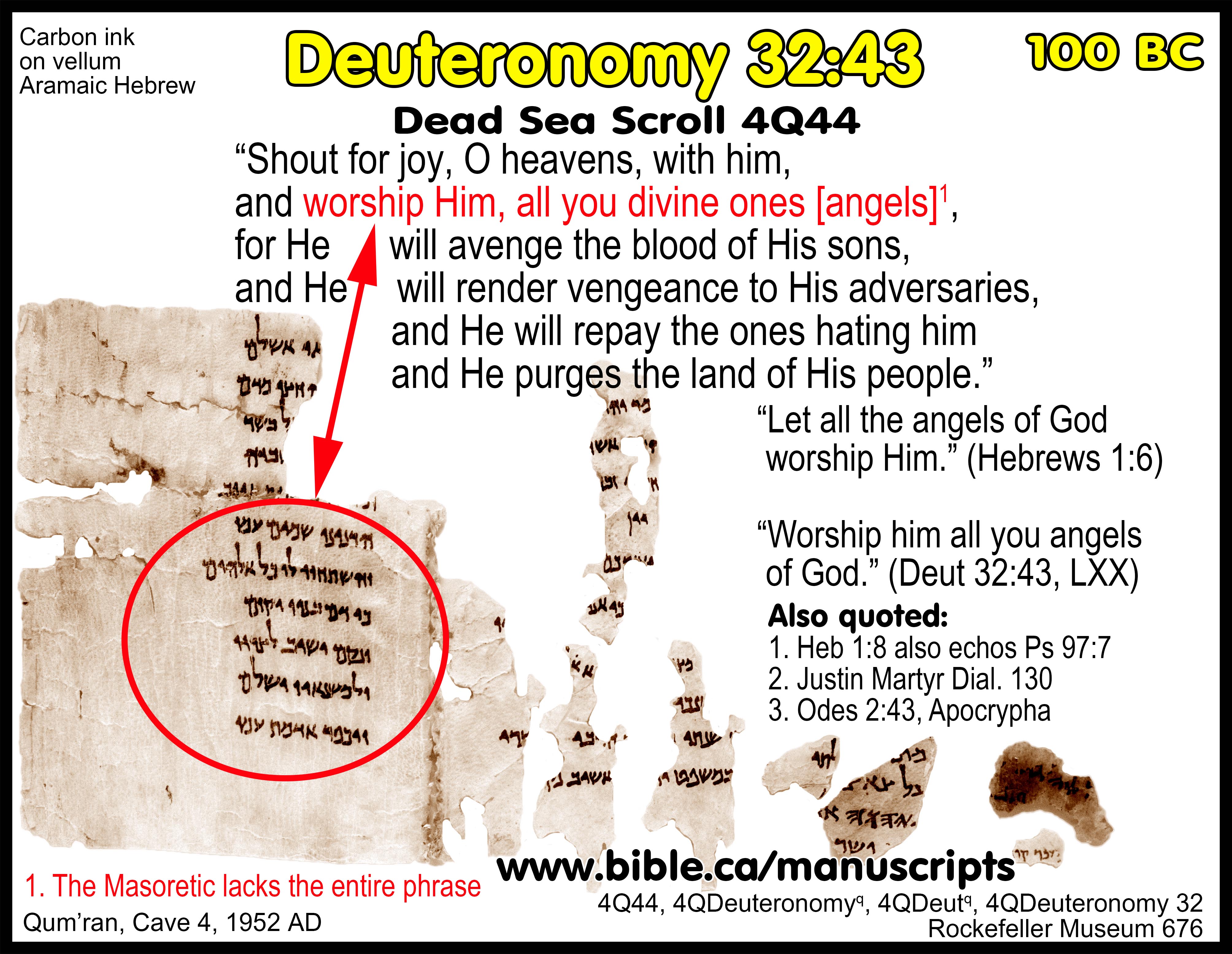
b. The
70 weeks of Daniel 9 end in 33 AD with the resurrection of Christ in the
LXX. The Masoretic Text used by all Christians has the messiah cut off in the
middle of the lasts week causing confusion. The Septuagint Vaticanus, says
nothing about the Messiah getting cut off but instead says he completes his
work at the END of the last week:
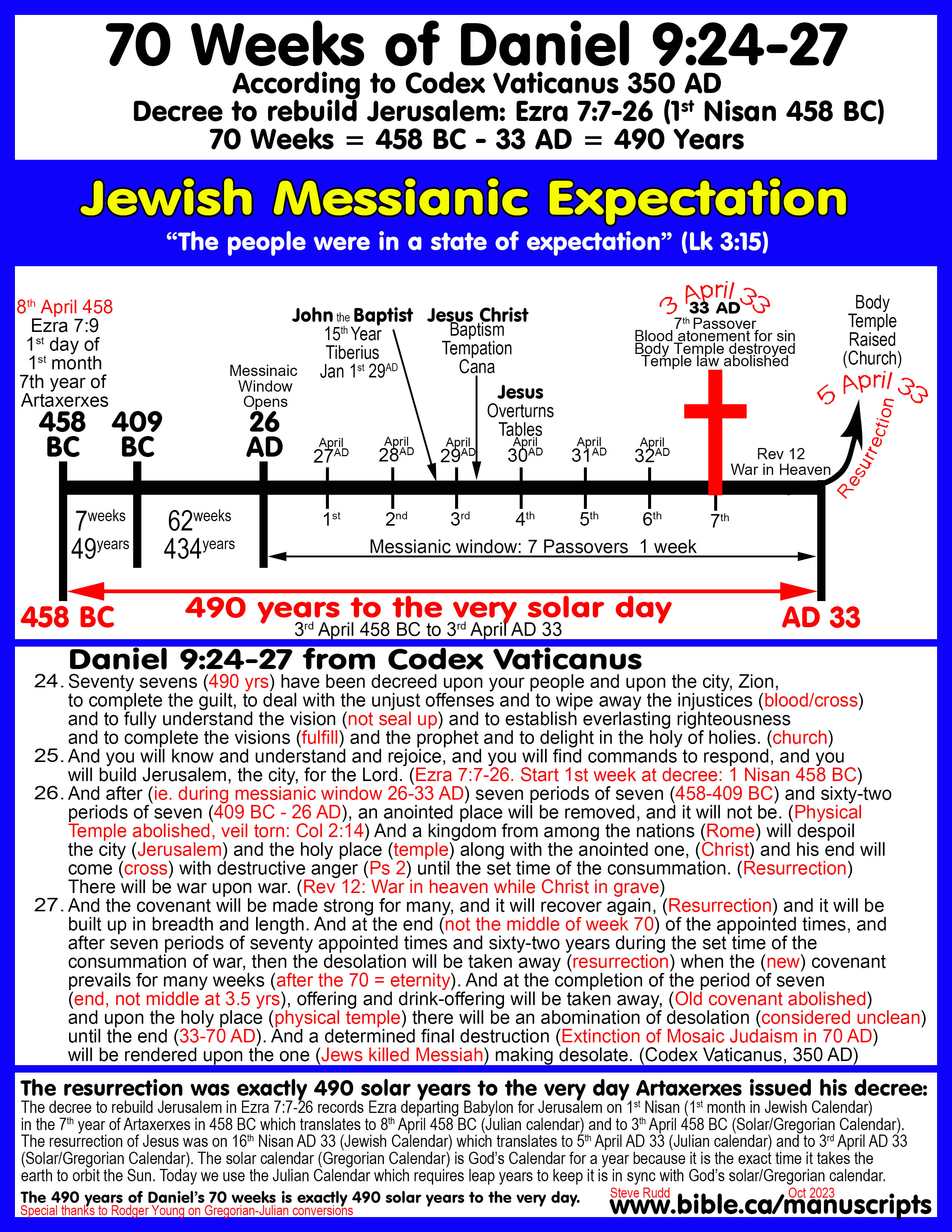
5. Ussher’s creation date of 4004 BC:
a. Ussher was as wacky as the authors of Seder Olam because he taught the earth would exist for a maximum of 6000 years.
i. Ussher ignored hard facts of the actual numbers in the Bible and instead squished the real numbers into an artificial self-fabricated design.
ii. Seder Olam used jubilees, Ussher used the days of creation + 2 Pe 3:8. (A day = 1000 years)
iii. Both are examples of starting with a set of false assumptions and arriving at an even falser conclusion.
iv. Ultimately, Ussher was deceived by the chronological numbers in the Masoretic text that had been corrupted in 160 AD at Zippori.
b. Commentary:
i. “Ussher probably is best known for his conclusion that the Creation Week began on October 23, 4004 BC. In most people's minds, this is the source of the common belief among biblical creationists that the world is only about 6000 years old. However Ussher was not the first, nor was he the only one, to attempt such a feat, for several contemporaries and near-contemporaries also computed ancient chronologies. Attempts to date creation this way predated Ussher by at least 15 centuries. In the second century AD, Rabbi Jose ben Halafta determined that the date of creation was 3761 BC. Also in the second century AD, Julius Africanus dated the creation to 5501 BC. The large discrepancy between these dates of creation mostly is due to the differences between the Septuagint and the Hebrew text of the Old Testament in the chronologies of Genesis 5 and 11. Africanus used the Septuagint, a decision that influenced many other early church chronologers, who reached similar dates for the creation. Eventually, the Hebrew text of the Old Testament became the preferred source. In AD 723 the Venerable Bede determined that the creation was in 3952 BC. Martin Luther thought that the creation was in 3960 BC, while his collaborator Philip Melanchton dated the creation to 3963 BC. John Lightfoot's chronology often is confused with Ussher's. Lightfoot published his work in 1644, just a few years before Ussher, in which he concluded that the creation was in 3929 BC. At least two astronomers weighed in: Isaac Newton determined that the creation was around 4000 BC, while Johannes Kepler concluded that the creation was in 3992 BC. This is just a small sample of various computations of the date of creation; Sexton (2015) recently has compiled several more sources with their various dates of creation.” (Comments on Ussher’s Date of Creation, Danny R. Faulkner, Answers Research Journal 9, p 163, 2016 AD)
ii. “Though Ussher did not explicitly state them in his book on chronology, there appear to be two assumptions that persuaded Ussher that he could determine the beginning of creation to the day. One assumption was that there were exactly 3000 years between the creation and the dedication of Solomon's Temple and another thousand years from the dedication of the Temple to the birth of Christ (Barr 1985). Ussher dated the birth of Jesus in 4 BC and the Temple's dedication to 1004 BC, so with this assumption, the creation must have been in 4004 BC. There is no biblical statement that requires this. Rather, this assumption probably stemmed from a common belief, dating to at least the early Middle Ages and the early Church, that there would be 6000 years of human history, in parallel with the Creation Week in light of 2 Peter 3:8 (which is an allusion to Psalm 90:4).” (Comments on Ussher’s Date of Creation, Danny R. Faulkner, Answers Research Journal 9, p 165, 2016 AD)
iii. “It seemed fitting to Ussher that the creation was exactly 3000 years prior to the Temple's construction, and exactly 4000 years prior to the Messiah's birth. Of course, that would anticipate the end of the age in AD 1997,exactly 2000 years after Jesus' birth and 6000 years after the creation. Since two decades have elapsed since 1997, enthusiasm for this belief has waned considerably in recent years. Yet, steadfast belief in the earlier 3000 year and 1000 year increments remains.” (Comments on Ussher’s Date of Creation, Danny R. Faulkner, Answers Research Journal 9, p 165, 2016 AD)
iv. “Ussher's date for creation appears strongly to rest upon two assumptions. The first assumption of 6000 years of history in parallel to the first six days of the Creation Week is no longer tenable, because we currently are two decades past 6000 years since Ussher's date of creation.” (Comments on Ussher’s Date of Creation, Danny R. Faulkner, Answers Research Journal 9, p 168, 2016 AD)
VIII 1st and 2nd Samuel corrupt in the Masoretic Text: See full outline: Variants in Samuel Outline
1. The Hebrew Masoretic Text (MT) of 1st and 2nd Samuel are universally recognized as “hopelessly corrupted” and is corrected by the copy of the Greek Septuagint (LXX) in possession of Christians in 350 AD.
a. The text of the book of 1 & 2 Samuel is solid and certain because we have the Septuagint (LXX).
b. Pictured above is 4Q51 Samuel a, [4QSamuela, 4QSama]: Frgs. 100-101, 2 Samuel 12:14-20
c. 1 & 2 Samuel as found in the Septuagint (LXX) is validated at the variant of 2 Samuel 12:14-20 by three Dead Sea Scrolls: 4Q51-4QSama, 4Q52-4QSamb and 4Q53-4QSamc proving the Hebrew Masoretic to be corrupted.
2. Example of corruption: 1 Samuel 13:1
a. The MT reads: “Saul was a year old when he began to reign, and he reigned two years over Israel.”
b. Septuagint Lucianic LXXL lists Saul’s age as 30 when he became king. After all, Jonathan his son defeated the Philistines at Geba in the first year of Saul’s reign.
c. Again, the New Testament saves the day giving us the precise number of years Saul reigned: 40 Years.
d. “Then they asked for a king, and God gave them Saul the son of Kish, a man of the tribe of Benjamin, for forty years." (Acts 13:21)
3. While Jewish Rabbis today reject the Septuagint, they are unaware (or in blind denial) that with out the LXX the Jews would not have a book of Samuel.
4. See full outline: Variants in Samuel Outline
Conclusion:
1. On two different historic occasions, the Jews corrupted their own Bible to counter theological adversaries. The Jews in 160-200 AD corrupted the Genesis chronology for anti-Christian purposes unknowingly following in the footsteps of Ezra in 458 BC who, for anti-Samaritan purposes, changed the location of Joshua’s alter from Mt. Gerizim to Mt Ebal as he converted the Paleo-Hebrew Tanakh into Aramaic Hebrew. Noah got drunk, David committed adultery. Perhaps this one textual corruption was Ezra’s great sin. Notice that in both cases, the entire collection of Hebrew manuscripts were entrusted into the hands of a small number of Jews who created a single manuscript that would come to dominate the world, all within a population who were Hebrew illiterate and would be unable to detect the changes.
2. The “Masoretic Text” used in all modern Christian Bibles today was created and standardized around 160 AD at Zippori.
a. 400 years
later the Masoretes would make no alterations to the text except adding vowels:
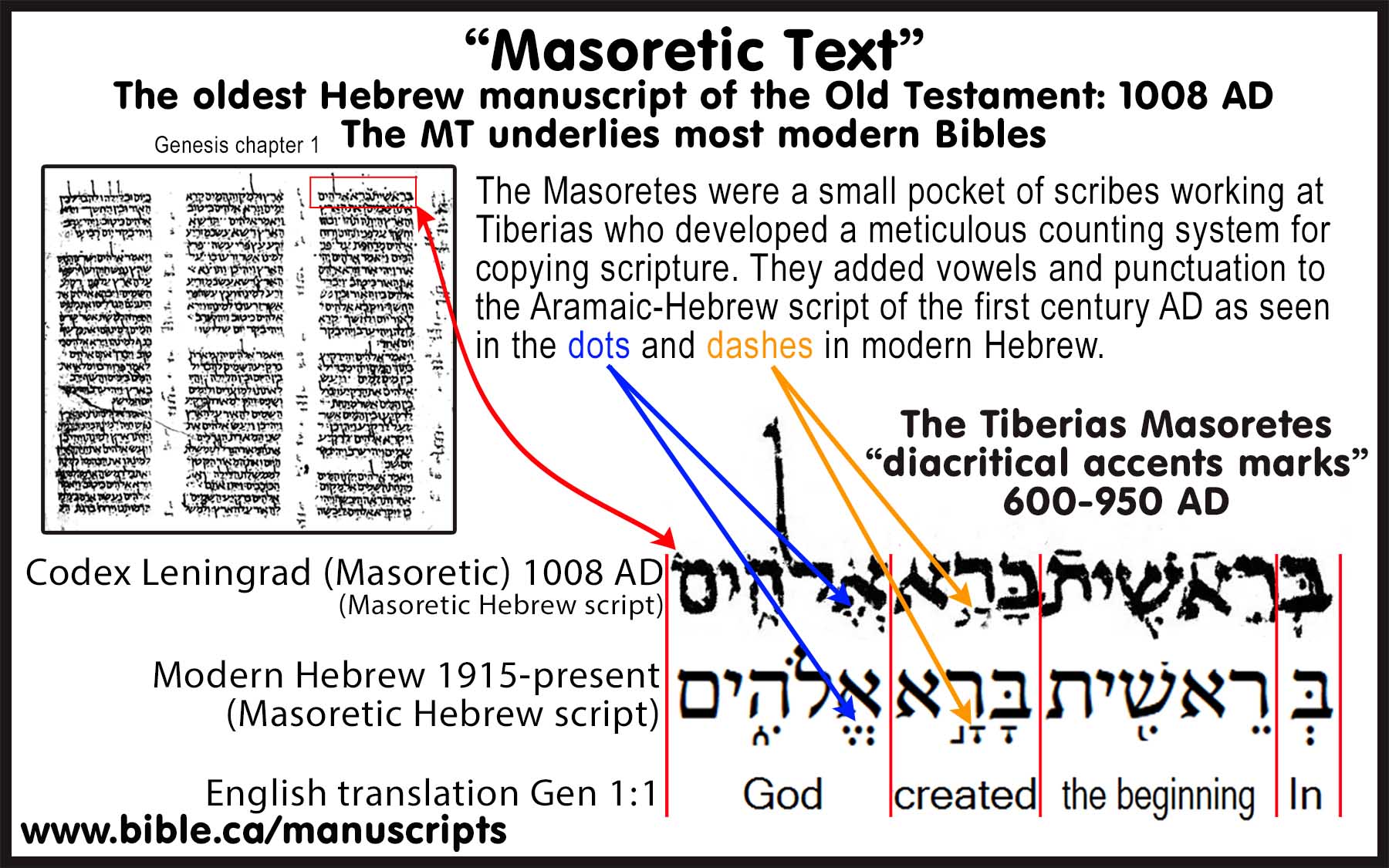
3. The devil achieved much but still lost: "Scripture cannot be broken" (Jesus, John 10:35)
a. The Jews today refuse to even read the New Testament and always blindly believe their Hebrew scriptures are superior to the Greek Septuagint so the Devil holds them in deception.
b. Christians who rightly identify Jews as having changed their Tanakh create ammunition for unbelievers to reject the entire Bible, so the Devil holds them in deception.
c. But in the end, none of the changes made by the Jews changed any critical text or changed any doctrine, so they failed.
d. Many Jews today are converting to Christianity as a result of simply reading the New Testament for the first time!
4. The same hatred and jealously that led the Jews to lie that Jesus did not rise from the dead, but that the disciples stole the body, led them to change their scriptures.
a. "And they left the tomb quickly with fear and great joy and ran to report it to His disciples. And behold, Jesus met them and greeted them. And they came up and took hold of His feet and worshiped Him. Then Jesus said to them, “Do not be afraid; go and take word to My brethren to leave for Galilee, and there they will see Me.” Now while they were on their way, some of the guard came into the city and reported to the chief priests all that had happened. And when they had assembled with the elders and consulted together, they gave a large sum of money to the soldiers, and said, “You are to say, ‘His disciples came by night and stole Him away while we were asleep.’ “And if this should come to the governor’s ears, we will win him over and keep you out of trouble.” And they took the money and did as they had been instructed; and this story was widely spread among the Jews, and is to this day." (Matthew 28:8–15)
b. Out of hatred for Christians who quoted the Jewish Greek Tanakh (Septuagint) to prove Jesus was the messiah, and having their temple destroyed by the Romans, the tiny remnant of surviving Jewish leaders sought for a way to prove Jesus CANNOT be the Messiah. The solution was the reduce the age of the earth by 1250 years which would push Jesus outside of the “window of the coming of the messiah”. They achieved this in two ways. First they compressed world history like an accordion by saying, in one of several examples, the Persian empire ruled the world for 52 years instead of 206 years (154 year reduction). But the Old Testament doesn’t contain any chronological numbers for the Babylonian, Persian, Greek or Roman empires of the Daniel 2 prophecy, so changing them achieved nothing tangible in arguing with Christians. Second, they fudged the actual chronological figures in the Hebrew text of Gen 5, 11 which indeed reduced the age of the earth by 1386 years. With the Hebrew language extinct in 300 BC except the Jerusalem elites and a few other’s, and the fact that Jews everywhere had been using the Greek Bible in all their synagogues for close to 400 years, changes in the Hebrew text would go unnoticed. But it achieved their goal because Jesus was born in 1BC but the new revised age of the earth as seen reflected in the modern Masoretic Text, meant the earliest the messiah could come was 118 AD. And that is how the numbers read in most modern translations today like the NASB and KJV.
5. Henry Smith astutely comments: "The Seder Olam Rabbah, known for its severe reduction of the timeline between the exile and Christ, is the earliest witness to the chronology in MT Genesis 5 and 11. That is, the earliest witness to the MT's begetting ages is a corrupted second-century Jewish history that reduces postexilic chronology to avoid the Christian interpretation of the Messianic prophecy in Daniel 9:26. Even aside from considerations of the Seder Olam's compromised nature, the earliest witness to the longer chronology (LXX) predates the earliest witness to the MT's shorter chronology by about 400 years. If the MT's chronology is original, why did it disappear until the second century AD, and why did the longer chronology prevail in both Hebrew and Greek sources until then? Any defender of the MT's numbers must address this question first. What could have motivated the second-century Jews to deflate their sacred chronology so significantly? Prevalent among Jews and early Christians was the belief that the Messiah would arrive during the sixth millennium after creation, between AM 5000 and AM 6000 (AM = Anno Mundi, "in the year of the world"). The Babylonian Talmud further suggests that according to some Jews, "the period of the Messiah" spanned from AM 4000 to AM 6000. The LXX's chronology puts the birth of Jesus at ca. AM 5500, clearly "qualifying" him (with respect to the age of the world) to be the Messiah. Many scholars have argued that the Palestinian Jews living in the second century AD shortened the chronology to remove Jesus from the sixth millennium of the world, thereby disqualifying Him as the Messiah (215-16, n. 129). This reduction is likely reflected in the Seder Olam, which (dating creation to 3761 BC) even manages to put Jesus outside "the period of the Messiah," while situating the second-century Jews right on the verge of it. After all, the authors of the Seder Olam were not opposed to manipulating Jewish chronology for Messianic (anti-Christian) reasons, for they indisputably reduced the interval between the Babylonian captivity and the Second Temple's destruction by about 185 years, supporting the Jewish attempt to correlate the Messianic prophecy in Daniel 9:26 with the events of AD 70 instead of with Jesus Christ. We propose, then, an adequate motive for Palestinian Jewish scribes to alter the sacred text, a motive that is supported by historical and theological evidence: discrediting the Lord Jesus as Messiah. Judaism was facing a crisis of biblical proportions (literally) during the second century of the Christian era. The gospel of Messiah Jesus was spreading like wildfire across the Roman world, the Temple had been razed to the ground, and the holy city of God had been burned. The rest of Israel had been ravaged by Roman aggression in the events of AD 66-73 and AD 132 -136. The small core of Judaism that rose from the ashes had complete and autonomous control over the Hebrew manuscripts that survived the Roman devastations,' providing ample opportunity for wholesale chronological changes that would go undetectable in later copies. Most of the world around them would have been unable to read the Hebrew texts, greatly minimizing their usefulness and dissemination outside Palestinian Judaism. These remaining manuscripts were the precursors to the Masoretic Text, which solidified during the last part of the first millennium AD. The circumstances in Palestine during the middle of the second century AD provided an ideal opportunity for the keepers of the remaining Jewish Scriptures to corrupt their texts without leaving behind a trail of evidence in the Hebrew manuscripts. Numerous church fathers testify to the lengths to which orthodox Judaism went to discredit Jesus' Messianic office, a phenomenon also recorded throughout the book of Acts. Justin Martyr says that the Rabbis deliberately expunged or altered Messianic verses from their Scriptures in their project of discrediting Lord Jesus as Messiah (e.g., see Dial. 71). According to Justin, the second-century Jews were still promulgating the lie that the disciples had stolen Christ's body from the tomb (cf. Mt 28:13-15). Augustine writes that "the Jews, envying us for our translation of their Law and Prophets, have made alterations in their texts to undermine the authority of ours" (Civ. 15.11). In a spiritual context that included the crucifixion of Jesus, the murder of Stephen, the attempted murder of Paul, virulent second-century opposition to the gospel, and a willingness to alter and even take away from the words of Scripture, the deliberate corruption of the primeval chronology easily falls within the realm of possibility. The theory that the second-century Palestinian Jews deflated the primeval chronology for anti-Christian reasons supplies the motive, means, and opportunity that no other theory can." (Primeval Chronology Restored: Revisiting the Genealogies of Genesis 5 and 11, Jeremy Sexton, Henry B. Smith Jr. Bible and Spade, 29, no. 2, p 47, 2016 AD)
6. We can be certain today, that the Septuagint chronology of Gen 5 & 11 contains the correct age of the earth at 5554 BC and the Masoretic are corrupted at 4174 BC.
a. In the final analysis, we can be certain that we possess the word of God!
b. This is what Jesus meant, when He said: "Scripture cannot be broken" (Jesus, John 10:35)
c. "My word will accomplish what I desire and succeed in the purpose for which I sent it." (Isa 55:11)
7. Many Jews today are converting to Christianity as a result of a simple reading the New Testament for the first time!
|
The Septuagint LXX “Scripture Cannot Be Broken” |
|||||
|
Start Here: Master Introduction and Index |
|||||
|
Six Bible Manuscripts |
|||||
|
1446 BC Sinai Text (ST) |
1050 BC Samuel’s Text (SNT) |
623 BC Samaritan (SP) |
458 BC Ezra’s Text (XIV) |
282 BC Septuagint (LXX) |
160 AD Masoretic (MT) |
|
Research Tools |
|||||
|
Steve Rudd, November 2017 AD: Contact the author for comments, input or corrections |
|||||
By Steve Rudd: November 2017: Contact the author for comments, input or corrections.
Go to: Main Bible Manuscripts Page
